
® July Augustl 2016 |Issue 20-04 | eatmagazine.ca RESTAURANTS | RECIPES | WINES | FOOD | TRAVEL
Local. Delicious. For a delicious riff on moules marinières steam local Saltspring Island mussels in BC Riesling with a bright note of dill. RECIPE, PAGE 5 Summer Fresh
Smart.



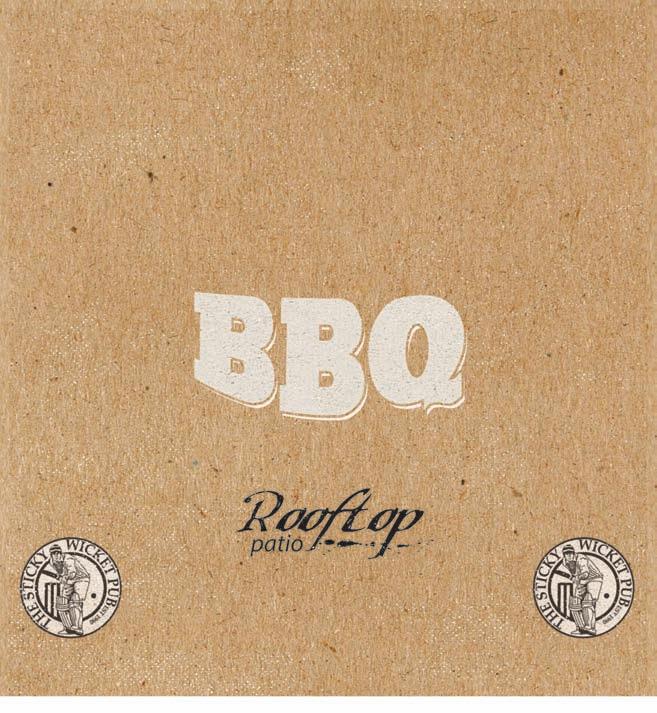










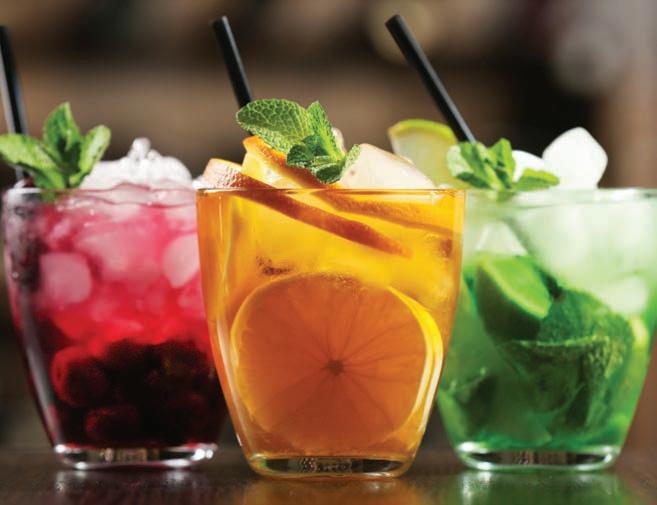









Bro admead V Vi ll age, 1 130- 777 R Royal O Oak D Dri ve, V Victori a, B BC www.pennaki tc he n.co m, 2 250- 727-2110, I Info @p ennakitchen.c om Made in the USA. Durable. Oven, microwave and dishwasher safe. for people who love to cook FiestaWare HOTELGRANDPACIFIC.COM | 250.380.4458 | BE SOCIAL WITH US
FOUNDER & EDITOR Gary Hynes
PUBLISHER Pacific Island Gourmet
SPECIAL PROJECTS EDITOR Colin Hynes
CONTRIBUTING EDITOR Carolyn Bateman
VANCOUVER CONTRIBUTING EDITOR Julie Pegg
SENIOR WINE WRITER Larry Arnold
ART DIRECTION Gary Hynes
COPY EDITOR Cynthia Annett
REGIONAL REPORTERS
Tofino | Ucluelet Jen Dart | Victoria Rebecca Baugniet | Cowichan Valley-Up Island
Kirsten Tyler
CONTRIBUTORS







Larry Arnold, Joseph Blake, Michelle Bouffard, Holly Brooke, Adam Cantor, Cinda Chavich, Jennifer Danter, Pam Durkin, Gillie Easdon, Jeremy Ferguson, Colin Hynes, Tracey Kusiewicz, Sherri Martin, Elizabeth Monk, Michaela Morris, Elizabeth Nyland, Tim Pawsey, Julie Pegg, Kaitlyn Rosenburg, Adrien Sala, Shelora Sheldan, Michael Tourigny, Sylvia Weinstock, Rebecca Wellman.
Since 1998 | EAT Magazine is published six times each year. No part of this publication may be reproduced without the written consent of the publisher. Although every effort is taken to ensure accuracy, Pacific Island Gourmet Publishing cannot be held responsible for any errors or omissions that may occur. All opinions expressed in the articles are those of the writers and not necessarily those of the publisher. Pacific Island Gourmet reserves the right to refuse any advertisement. All rights reserved.
OUR ETHICAL GUIDING PRINCIPALS
1. EAT has advertisers in our magazine and on our website; they are our primary source of income. Our company, Pacific Island Gourmet, employs a dedicated advertising team responsible for selling ad space in EAT and on EatMagazine.ca. The EAT editorial team does not accept money or other consideration from companies as a condition or incentive to write a review or story. All editorial content on EAT is based on the editor’s discretion, not on the desire of any company, advertiser or PR firm. Occasionally EAT and EatMagazine.ca may publish sponsor content, which will be labelled.
2. EAT contributors are not allowed to ask for free meals or drinks. Anyone identifying themselves as being on assignment for EAT will be able to prove their employment.
ADVERTISING
SENIOR
DIRECTOR Gary Hynes
ACCOUNT MANAGER Susan Worrall
DIRECTOR OF BUSINESS DEVELOPMENT
 Lindsay Van Gyn VANCOUVER SALES Clevers Media
Lindsay Van Gyn VANCOUVER SALES Clevers Media


HOW TO REACH EAT MAGAZINE
ADVERTISING 250.384.9042, editor@eatmagazine.ca
WEBSITE EatMagazine.ca

MAILING ADDRESS Box 5225, Victoria, BC, V8R 6N4 TEL 250.384.9042









EMAIL editor@eatmagazine.ca
PICK-UP THE MAGAZINE EAT is delivered to over 300 pick-up locations in BC including Victoria & Vancouver, Vancouver Island. Visit our website for locations
Publisher Pacific Island Gourmet | EAT ® is a registered trademark.


3 www.eatmagazine.ca JULY | AUGUST2016 Customer Care: 1.800.667.8280 | thriftyfoods.com Our robust, intense and incredibly full flavoured Dry Aged Beef delivers a depth of flavour that no cooking method or other process can reproduce – its taste is incomparable to everything else! The almost buttery texture of this robust, intense, incredibly full flavoured beef will delight the taste buds of you and your guests. Available at our Fairfield & Broadmead locations only. Experience the mouthwatering flavour of Dry Aged Beef Dry twitter.com/EatMagazine instagram.com/eatmag Facebook/EatMagazine www.eatmagazine.ca Sign-up for our Tapas newsletter EAT
Blue Crab Seafood House Refreshingly Local
Blue Crab Seafood House looks out on Victoria’s busy harbour from a wall of windows. Every seat in the sprawling restaurant off the lobby of the Coast Victoria Harbourside Hotel has a waterfront view. On a warm, bright afternoon in May, I tuck into a small table with a big view and talk to Kelley Schaefer, Blue Crab’s enthusiastic director of food and beverage, about the history, consistent vision and future of the Blue Crab.
“The fishmongers provide daily inspiration for our kitchen. For 25 years, that’s been the DNA of the Blue Crab. We have seasonal campaigns summer, fall and winter,” Schaefer continues. “Oysterfest, Prawnfest, halibut season, spring salmon. During summer season, “Chalk It Up” features a variety of appetizers and entrees inspired by the daily catch. No two days are the same. In the fall, we celebrate the local autumn harvest - from sea and farm.. We call our winter season “Feast.” Chef creates set menus at $35, $45 and $55. It’s a super value.”
The chef at Blue Crab is Geoffrey Tintinger, a South African-bred, globe-trotting kitchen star who has been at the restaurant since October 2015. After a resume that includes high-end cooking in exotic locales like Mauritius and the Seychelles, Tintinger is inspired by this coast’s marine abundance and quality.
“Seasonally, we profile the best fresh fish available—Arctic char and sustainable steelhead in winter, halibut and coho in summer and Dungeness crab all year round,” Tintinger tells me. “We combine modern gastronomy techniques with classics ones, and the whole kitchen team has input into menu creations.”
Blue Crab Catering has access to private waterfront dining and event space for groups of 20-120 within Coast Victoria Harbourside Hotel and a seasonal covered patio just off the restaurant’s harbourside perch.
Schaefer joined Blue Crab in January by way of three years in Tokyo where he was director of wine at a very exclusive private members club (Tokyo American Club). He’s spent decades working overseas from Dubai to the Maldives, even serving as private wine instructor for Madonna and her then-husband, filmmaker Guy Ritchie.
“We have a wine of the month program,” Schaefer says with a quiet enthusiasm. “A winery is selected and three to five pours are offered by the glass. We also have a new lounge menu with a page of local, craft beer, cider, wine, gin and boutique tonics. Sandhill, Grey Monk, Hatch, Unsworth, Burrowing Owl, Laughing Stock are all participating in the wine of the month program,” the sommelier continues. “Coast Hotel branding is ‘Refreshingly Local.’ That sums up what Blue Crab is doing.” —By
Joseph Blake
Blue Crab Seafood House
146 Kingston St., Victoria, BC, bluecrab.ca 250.480.1999
DEPARTMENTS
05
g Features
24 Edible Seaweeds
Nutritious and full of flavour, sea vegetables are washing up on B.C. menus.

28 Condiments
Monthly
Fresh
Taking cues from global flavours, get onboard the condiment train where you can shake, slather, sprinkle and pour your way through a multitude of chutneys, salsas, pastes and spice mixes.
32 The Interview
Brea Segger & Todd Howard of Pacific Rim College
g Recipes
36 Oh, Spare me!
A backyard summer barbecue.
g Wine, Spirits & Beer
40 Beer & a Bite
Spinnakers Lager & pie and ice cream
41 Cocktail of the Month
Rum cocktails
42 Wine + Terroir
Natural Wines
45 Liquid Assets
Larry Arnold’s recommended wines
g Community
46 The Buzz: Up Island, Uclulet & Tofino

FROM THE EDITOR
g Food
06CITY EATS
calendar of events, festivals
news
Matters
&
09Food
peas
BURNER Croissants
For You Summer salads
Dish A day at Yonni’s Doughnuts
Restaurants 12 Restaurants The new reality 16 Reporter Nubo Japanese Tapas, Artisan Bistro 20 Eating Well For Less Saltchuck Pies, Maria’s Souvlaki, Ox King Noodles
10FRONT
11Good
39The
g
4 EAT MAGAZINE JULY | AUGUST2016 content
Local. Delicious.
Smart.
EAT
SPECIAL PROMOTION
Christine Comrie of Cenote Restaurant and Lounge
INSIDE + WHAT’S NEW AT EAT
A DECADE AGO, DINING OUT MEANT dressing up, white tablecloths, and buttondowned waiters. How that’s changed. Now you’re as likely to line-up at a counter to place your order as you are to share small plates wearing jeans or shorts. What’s not changed is the high caliber of the food. Although restaurants are under increasing pressure to find ways to cut costs, they still are managing to bang out fine-dining quality plates.
With this in mind, Adrien Sala explores the changing face of dining on page 12. Elsewhere in this issue of EAT magazine, we visit a gorgeous farm on the Saanich peninsula, learn all about edible seaweeds, the coolest new local ingredient (which also happens to be one of the healthiest), and our resident food expert, Shelora Sheldan, explores global condiments to spice up your table. And, wine lovers will want to geek out over the story on natural wines by Michelle Bouffard.
What’s new at EAT? The EAT Journal is out and is for sale in bookstores, specialty food shops, grocers, and select cafés around BC (see page 19 for a list of stores by region). I’m incredibly proud of the team that worked on our first journal project. Inside it you’ll find recipes from Jennifer Danter, Rebecca Wellman, Jill Van Gyn, Julie Pegg, Kunal Ghose, Jeff Keenliside and John Waller. The works of local photographers Michael Tourigny, Rebecca Wellman, and Caleb Beyers are on display. There’s an international component with a beautiful photo essay by Helsinki-based photographer Anton Sucksdorff, as well as a whimsical illustration by Bristol, UK native Emily Nash. We also go deep with stories on food & design, BC’s sustainable fishery, and a First Nations traditional pit cook. We hope you enjoy our new endeavour as much as we enjoyed making it!
For more information or to order a copy visit TheEatJournal.com
g COVER RECIPE By Gary Hynes
Saltspring Mussels Steamed in BC Riesling
3 Tbsp unsalted butter*
We are excited to be working with an amazing group of local farmers, foragers, fishers, brewers, distillers, winemakers and many other specialized awesome people.
NOW OPEN FOR BRUNCH AND LUNCH
509 Fisgard Street, Victoria, BC (250) 590-8795
WWW.OLORESTAURANT.COM


SERVES 2
1 clove garlic, peeled and finely chopped
4 shallots, peeled and finely chopped
1⁄2 tsp fresh thyme, chopped
1 kg fresh mussels, scrubbed and debearded
1⁄2 cup British Columbia Riesling wine
(I used the well-balanced JoieFarm Riesling)
1 Tbsp fresh dill, chopped
2 Tbsp fresh Italian parsley, chopped Pepper to taste
*Musssels can be salty so be cautious about adding extra salt.
I first time I ate mussels was when my father took me along on a business trip to Toronto. It was also my first experience in a fine dining restaurant. The black-tied waiter brought out an enormous copper cauldron brimming with P.E.I. mussels that had been steamed in white wine and doused with heavy cream and set it down in front us. It was a simple dish - yet absolutely delicious.
For my take on steamed mussels I lose the cream and use local Saltspring Island mussels, B.C. Riesling white wine from the Okanagan and a scatter of fresh dill. This recipe was adapted from J.K. The Jamie Kennedy Cookbook (HarperCollins).
RINSE THE MUSSELS in cold water and discard any with broken shells.
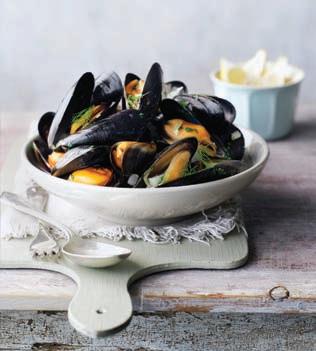
Melt the butter in a large saucepan or pot. Add the garlic and shallots and gently sauté for 3 minutes. Add the thyme and mussels and sauté for an additional 1 minute. Add the wine and dill, increase the heat and cover. Boil until the mussels open, approximately 5 minutes. Discard any mussels that don’t open.
Meanwhile, warm 2 large bowls. Arrange mussels in a pleasing pattern in each of the bowls. Sprinkle with the parsley.
Serve with frites and lemon slices and don’t forget the baguette to sop all the precious liquid.
5 lwww.eatmagazine.ca JULY | AUGUST2016 victoria 1317 blanshard north vancouver 1230 lonsdale vancouver 377 howe & 1548 broadway cookculture.com The quickest way to make things more fun and delicious? Add some fresh air and sunshine to every meal. We have everything you need to get more from your outdoor entertaining. take it outside | Editor’s Note |
Gary Hynes
Maja Smend
city eats

 by Rebecca Baugniet
by Rebecca Baugniet
g Bao Restaurant opened mid-June. This Southeast Asian Fusion concept restaurant restaurant is brought to you by former Noodle Box Executive chef Arthur Webb and front of house manager Kylie Arnot. It offers mostly Chinese, Taiwanese, Korean and Japanese influences. The restaurant will have 5 rotating bao buns, bibimbap bowls, ramen, noodle dishes and appetizers as well as cocktails and local beer on tap. (facebook.com/bao)
g The corner of Government St and Courtney St was home to Mirage Coffee for many years, but now has a new owner and new look. Pour Coffee opened earlier this spring. Their focus is to provide quality, locally crafted, full-bodied coffee and high quality gelato and baked goods. (pourvictoria.ca)
g Andrea Sims, owner of the Rathskeller Restaurant, has announced she will be closing the popular Bavarian restaurant later this year. Her father, the late Franz Krieger, opened the restaurant in the basement of a hotel on Douglas Street in the 1960s. The Rathskeller has been at its present Quadra St location since 1982. (rathskeller.ca)
g The Empress Hotel dining area renovations were completed this spring and The Empress Room has now reopened as Q at the Empress. From their website: “Q
represents Queen and country, a nod to Queen Victoria, with a modern twist on royalty. A singular letter, for a very singular space.”
(fairmont.com/empress-victoria/dining/q-at-the-empress)







g Hold: Tools for Simple Living opened in early June on Craigflower, just a couple of doors down from Fry’s. In addition to a pretty selection of house goods, the shop is selling local produce, kombucha, potted herbs and vegetable starts. (holdgeneral.ca)



g A new health-centered food business opened at 1314 Douglas St this past May. Fit Fix Café is a health conscious café offering eat-in and take-out options at the café as well as catering and meal prep services. (facebook.com/FIT-FIX-CAFÉ)
g Victoria’s organic, farm-to-table restaurant OLO is pleased to announce that it has opened its doors for lunch on Monday to Friday from 10am to 2pm, and weekend brunch from 9am to 2pm. (olorestaurant.com)
g In local food business closures, The Clay Pigeon at the corner of Blanshard and Broughton locked its doors on June 1st. And after suffering string of challenges, including a flood at the end of May, Solstice Café on Fisgard St. appears to have permanently closed its doors. Stay tuned for updates on what will be coming next to these two locations.
g Local breakfast favourite, The Village Restaurant, has opened a new location in Gordon Head, and with it comes more environmentally sustainable menu offerings, as well as an exciting return “home” for owner/operator Brian Bobiak. Born and raised in Victoria, Bobiak grew up just a couple blocks away from this new location on Torquay Avenue. (thevillagerestaurant.ca)
g Congratulations to owners Cory and Madone Pelan and the whole gang at The Whole Beast who just celebrated their 5th anniversary on June 28th! (thewholebeast.ca)
g On July 1, tea fans will raise their cups to celebrate a national first. Canada’s only working tea farm is releasing the first estate-grown Canadian tea. Teafarm is an elevenacre organic farm, teashop and gallery in the Cowichan Valley. Founded by husband and wife team, Victor Vesely and Margit Nellemann, Teafarm imports and sells premium
BALANCE: QUALITY, CREATIVITY, & EXECUTION. “Outstanding! From the food to the cocktails, to the invi ng yet contemporary atmosphere, what a gem.” Down the Hall, 506 Fort St. www.li lejumbo.ca 778.433.5535 Reserva ons accepted Open 7 days a week 5 PM un l late Happy Hours 5 6 PM and 10:30 un l close 6 EAT MAGAZINE JULY | AUGUST2016
organic and biodynamic loose teas from around the world, creates artful tea blends, and features ceramic tea ware, as well as growing tea. (teafarm.ca)
g 2016 is Moss Street Market’s 25th season of providing local and organic farm-fresh produce, local foods, handmade crafts, artisan clothing, inspiring services and community education to folks from the entire Victoria & area region. The regular season goes from May through October, every Saturday, 10am to 2pm , rain or shine at the corner of Moss Street and Fairfield Road. (mossstreetmarket.com)
g Since its beginning in 2012, the Oaklands Sunset Market in Saanich has grown in size and frequency and now includes up to 50 vendors representing fresh produce, prepared food, hot food, arts and crafts, local non-profits and small businesses. Last summer they introduced Bottles Sales on their off-weeks from Beer Garden nights. This means you can taste test your favourite local wineries, breweries, and cider-houses and take home a bottle or two. Every Wednesday until Sept 2 (no market on July 1), from 4:30-8:30pm. The corner of Belmont Ave. and Ryan St. at Oaklands Community Centre Basketball Courts. (oaklandscommunitycentre.com/markets)
g On the second Wednesday in July, August and September, the Oak Bay Night Market turns Oak Bay Avenue into a European style market between 4 and 8 pm. Each market features an in-season produce theme with fresh produce from southern Vancouver Island. In 2016 Markets will be held on July 13, August 10 and September 14. (oakbay.ca)
g The Victoria Downtown Farmers' Market promises homegrown and handmade, all year round. Every Wednesday, Saturday and Sunday from 11AM-3PM, the market features the region’s best farms, freshest food, friendliest vendors, demonstrations and finest musicians. Take your re-useable bags and fill up on local goodies. Check out their Vendor Calendar online to see who's coming and when: (victoriapublicmarket.com/market-calendar)
g The Esquimalt Farmers’ Market believes in supporting local growers and producers and those who engage in environmentally sound, farming practices. They want to encourage backyard farmers to help nourish their community with their quality products. This encourages local sustainability and neighbourly interaction. The market features farm produce and plants, edibles, food trucks and more. This year the market has a dog area, run by the SPCA, where your pooch can stay while you shop. The price of this area will be set by the SPCA and they will maintain the dog sign in sheet. Dogs will only be allowed in the doggy daycare as space allows. Thursday nights from 4.308.30pm (esquimaltmarket.com)
g The annual Similkameen BBQ King event will be held on Saturday, July 9th from 5-9 p.m. at the Old Grist Mill & Gardens in Keremeos. Top chefs compete for the coveted title of Similkameen BBQ King or Queen.(similkameenvalley.com)

g Victoria’s eighth annual Taste: Victoria’s Festival of Food and Wine will uncork Thursday July 14, with an evening tasting of more than 100 British Columbia wines and local cuisine prepared by top Vancouver Island chefs. Not just a wine festival, this culinary tourism experience is an extra long weekend of tastings, seminars and events... a festival with a culinary conscience. Events run through to Sunday, July 17. Tickets sell out quickly. (victoriataste.com).
g The North Saanich Flavour Trail offers residents and visitors the opportunity to explore and experience Peninsula food and agriculture – and have fun. August 19-21. (flavourtrails.com)
EDITOR’S CHOICE
g Feast of Fields is FarmFolk/CityFolk’s annual fundraiser. Net proceeds support their work year round as they help to create a sustainable food system for British Columbia. This year’s Vancouver Island Feast of Fields is happening a little earlier than usual this year, hosted on Sunday, Aug 28, from 1-5 pm Parry Bay Sheep Farm's Glengarry Farm site at the edge of Metchosin's coastline (4659 William Head Road). This magnificent and agriculturally important backdrop shapes this year's culinary celebration of local sustainable agriculture. Amidst Garry Oaks, ocean bluffs and meadow grasses, the finest selection of Vancouver Island food and beverage is presented with passion from the chefs, vintners, brewers, farmers and crafters who define our island's epicurean expression. For ticket purchase information visit the Feast of Fields website. (feastoffields.com)
Heron Rock Bistro
Since
Since 2012
Lunch, Dinner, Local Beer & Wine
Top Quality Food & Drink in a Casual Fun Atmosphere
Open 7 Days 11am-11pm 10pm on Sundays
(Weekend 9am Brunch)
HAPPY HOUR
2:30-5:30pm 'and' 9pm to close.
7 www.eatmagazine.ca JULY | AUGUST2016
Gypsy Jazz, Funk & Soul
// Friday // Saturday
Hour 7 nights 8pm to Close
Monday to Friday
Saturday & Sunday
of Cro and Simcoe
Lunch, Dinner, Beer & Wine
2005 Live Music, Blues,
Monday
Happy
9am-10pm
8:30am-10pm
250.383.1545 • heronrockbistro.ca Corner
behind ri y’s Breakfast,
7 Days
Corner of Interurban & Wilkinson • 250.590.4556

Paella Meets Risotto








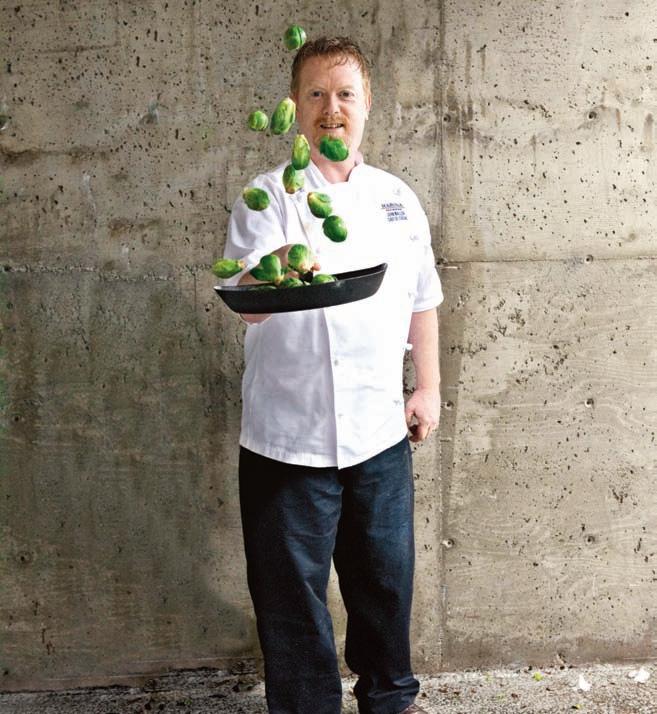
Catalunya (or Catalonia) is unique to Spain. It has a distinct language, peppered with a vocabulary similar to that of the south of France, the result of the region’s strong links with its neighbour in medieval times. Indigenous macabeo, xarello and parellada grapes are responsible for the delicious sparkling wines called cavas. Its cuisine is distinct as well. Catalunya puts its own stamp on such familiar ingredients as peppers, onions, tomatoes, garlic and olive oil. Everywhere and at all times, you come across pa amb tomàquet—toasted or grilled bread rubbed with fresh tomato and a garlic clove, doused with local Arbequina olive oil.





That explains the attractive display of deep red tomatoes, thick slices of bread, fresh garlic and cruets of deep green olive oil right next to the toaster in the Hotel Barcelona Golf’s breakfast room. It was for do-it-yourself fixing of toasted bread and tomato. Pity I had no idea until after the fact. Pa am tomàquet fixings appeared again at lunch. As did fuets (dried sausages, but, unlike chorizo, paprika-less), salt cod salad and an enormous paella pan of seafood and short vermicelli, not rice. This noodle-and-seafood combo, known as fideuà (fee-day-wa), was also new to me. Cataluyna’s salty waters boast brilliant seafood. I guess that’s why I never saw chorizo (or chicken or rabbit) in fideuà the way I do in many paellas. A dollop of allioli (the Catalan version of garlicky mayonnaise) is whisked in just before you eat it, rather than the squeeze of lemon common to paella. Traditionally, restaurants prepare a giant pan of fideos (noodles) brimming with mussels, squid and prawns, and perhaps some firm-fleshed local fish, to set mid-table for folks to gather round and dig in. Today’s trendier chefs present updated versions in individual earthenware dishes as a starter or part of a multi-course meal. Vicus Restaurant on the Costa Brava did wonders with three large rosy prawns perched atop delicately seasoned noodles. Cribbed from an online recipe, which calls for broken spaghettini, my first attempt at fideuà seemed to miss being
the real thing. “The taste is very good, but it is not fideuà,” admits Fernando, a colleague from Madrid, after sampling a bit. Although a Castilian not Catalan, Fernando knows his way around fideuà. “You must start with a good sofregit by slow cooking garlic, onions and tomato, and perhaps a little diced red pepper until the whole lot melts together.” Hmm—I didn’t do exactly that. “Did you first cook the prawns until just pink? Then take them out?” Well, no. I added them to the pan and cooked them at the end. And I added a bit of chorizo. I had committed two more sins—ladling in chicken stock (uh-uh!), stirring the mixture after each addition, until the liquid is absorbed, as I do with risotto. “You must use rich fish stock, [made] with the prawn shells. And Spanish cooks add all the liquid at once and do not stir it much. We are lazy,” says Fernando with a grin. His enquiry continues. “After you lifted the cloth, did the noodles curly up?” No cloth. And definitely no “curly up.” Clearly I needed to return to the kitchen.
Fernando’s Spanglish instructions deciphered, and with his recommendation to follow a Spanish chef’s YouTube video, I embark on a second fideuà go round. I recall that I have fish fumet in the freezer. I place it on a bare simmer with the prawn shells (large B.C. side-stripe prawns are ideal for fideuà).
Spanish olive oil is in the house, also Spanish saffron and paprika. The spices, omitted from the online recipe, are a must. A pinch and a dash respectively get added at the final stages of the sofregit.








Greek fides, angel-hair pasta nests, and Italian cappellini spezzati, short, thin, slightly curved noodles, are both sold at Parthenon Grocery, but I choose slightly larger capellini. About 25 minutes in there’s a lovely fragrant fideuà just like the one in the video—rather soupy looking, but the noodles have straightened. I take the pan off the heat and, as instructed, cover it with two tea towels. Ten minutes later I peek under the towels. The broth is absorbed. And just like in the video, the noodles have “curlied” up. Looks authentic and it’s darn delicious. Now, for Fernando’s opinion.

9 www.eatmagazine.ca JULY | AUGUST2016
g FOOD MATTERS IN SPAIN By Julie Pegg 250 598 8555 | www.marinarestaurant.com | 1327 Beach Drive at the Oak Bay Marina Classic dining. 100% CATCH OF THE DAY. Featuring CEVICHE #98DAYSOFSUMMER
g FRONT BURNER By Sharon McLean
huge following over the past 10 years. Peter Hunt, longtime master distiller at Victoria Spirits, explains that the name change is about emphasizing what they do, rather than what they produce.

The change also marks a significant re-focusing on cocktails. Hunt notes that the much-loved Victoria Gin was increasingly being used for cocktails, and Victoria Distillers embraces that. The website showcases cocktail recipes developed in collaboration with some of Canada’s leading bartenders, including local “shaker-heroes”
Solomon Siegel from Pagliacci’s and Katie McDonald, previously from Clive’s and Veneto. Even the new logo reflects this shift: the nine bottle tops symbolize the main categories of spirits and reflect the goal of creating “liquid tools” for innovative mixologists.
between noon and 4:30 p.m. The cost is $7 for adults and children under 19 are free. You can book online or by phoning 250-544-8217.
victoriadistillers.com, 9891 Seaport Pl., Sidney, B.C.








TASTING NOTES
Victoria Gin This is the spirit that put Victoria Spirits on the map. The basic recipe remains unchanged, but it’s been re-packaged and branded as V+ (Gold Medal, Beverage Testing Institute, Tasting Award, 2016, Winner at the Vancouver International Spirits Competition, 2016). It’s a restrained gin, where the juniper, citrus, floral and spice are all in balance, creating the perfect backdrop for a cocktail.
Victoria Distillers is now serving its award-winning spirits with water on the side. The waterfront distillery at Seaport Place in Sidney opened in May and is available for tours and tastings. A public lounge is coming soon— final approval of the license is pending—and will give visitors a chance to relax and pair classic and unique cocktails with light bites.
Victoria Distillers is the new incarnation of Victoria Spirits, the Saanich-based distillery that has developed a




The company’s original German still has been moved from Saanich and is joined by a new still designed and built by Specific Mechanical Systems in Saanichton. Hunt is excited by the opportunity the new still and additional space brings to expand the portfolio. He is looking to launch a rum, using sugar cane from Level Ground Trading, and as well as an amaro, a herbal liqueur that is ever-popular in cocktails. These will complement the established range of gins, whiskies and bitters:
Victoria Distillers is in the centre of Sidney’s popular waterfront area, a block from the Shaw Ocean Discovery Centre on one side and Port Sidney Marina on the other. It’s now open for daily tours starting every half hour
Oaken Gin This is Victoria Gin aged in French and American oak, giving it a sweet overlay of vanilla, caramel and candied orange peel. (Double Gold, San Francisco World Spirits Competition, 2016) Left Coast Hemp Vodka Using hemp from The Good Seed Hemp Co., a farm in Cobble Hill, this vodka is smooth and rich with a distinctive nutty and spicy aspect.
Craigdarroch Whisky This made its first appearance in 2015 and quickly sold out. It was smooth and soft with warm notes of vanilla, orange zest and spice, showing the distinct influence of oak aging. Fans should watch for the new release.
Twisted & Bitter A range of bitters that include orange, ginger, rosemary, grapefruit and black pepper. The new cocktail list features the “Left Coast Mule,” which brings together Left Coast Hemp Vodka with ginger sorbet, ginger beer and ginger bitters. Sounds perfect for the patio.
House Artisan Groceries Pizza-box Charcuterie Chefs' Menu











10 EAT MAGAZINE JULY | AUGUST2016
/ CAFFEFANTASTICO DOCKSIDE GREEN V I C
Cocktails with a twist of water view at Victoria Distillers’ new facility in Sidney.
Summer Salad Days



Elevate a salad to main-course status with three key nutritional elements.
During the summer months, salads step into the culinary spotlight—going from refreshing side dish to “no-fuss” main course. To ensure your salad is substantial enough for entree status and is truly health-enhancing, there are some critical aspects to consider. I recently sat down with Hillary Krupa, a resident nutritionist at InspireHealth, a not-for-profit supportive cancer care centre, to discuss just what is de rigueur when it comes to assembling a power-packed salad “meal” with both nutritional oomph and flavour.
EAT: What do you feel are the key components necessary to elevate a salad from side dish to entree?



HK: If a salad is going to be the main course it should, at a minimum, contain the three basic elements essential for any complete meal: a protein source, a complex carbohydrate and a healthy fat. If even one of these components is left out, the salad just won’t be sufficient enough to sustain energy levels or satisfy hunger.
EAT: OK, let’s start with protein—are there certain sources you prefer?
HK: Well, grass-fed beef and free-range poultry are fine options, but wild salmon, freerange eggs and hemp seeds are particularly beneficial because they’re not just excellent sources of protein, they also provide healthy fats. Of course, legumes, tempeh and full-bodied cheeses are also super options.







EAT: Ah yes, healthy fats—without them we can’t absorb the nutrients in those glorious salad greens. Studies suggest monounsaturated fats help us absorb the antioxidants in vegetables better than any other fat source. Olive oil for dressings is, of course, an obvious monounsaturated-rich choice. Which other monounsaturated oils do you recommend?

HK: Avocado, macadamia nut, walnut, hemp seed and pumpkin seed oils are all rich in monounsaturated fats and make absolutely delicious dressings. I also tell people to toss “whole-food” sources of monounsaturates into their salads, things like almonds, cashews, fresh avocado, olives, pine nuts. These provide wonderful texture and taste in addition to healthy fats. And, if you’re getting your fat from the whole food add-in, you can then opt for a creamy dressing made with plain yogurt or kefir and herbs if you prefer. One thing I think that’s really important to stress, though, is that people should be making their own simple dressings, not relying on store-bought varieties, which are, for the most part, full of overly refined vegetable oils and preservatives and rarely full of monounsaturates.
EAT: On to component three, complex carbs. I love the texture farro, wild rice and quinoa can add to salads and often suggest people use them as their “base” for first course salads instead of lettuce and then just throw in whatever veggies and protein they like. What are your favourites and why are these carbs so critical?
HK: I’d agree those are all nutritious options, but I’d add amaranth, buckwheat noodles, barley, black rice and sweet or baby potatoes to the list. These types of complex carbs are critical add-ins to salads because they provide fuel for the body. They also help to stabilize blood sugar and they’re necessary for optimal cognitive function.
EAT: There are myriad ways to prepare a salad, but the most common remains starting with a bowl of greens and going from there. What are your “leafy” loves?
HK: I adore bitter greens like endive and arugula because they help stimulate digestion. Watercress, Romaine lettuce and baby spinach, chard and kale are also nutritional winners. And finally, I find any salad incomplete without fresh herbs such as basil, parsley, tarragon. These all contain disease-fighting antioxidants PLUS they make salads delicious, a requirement that’s as paramount as being nutritious in my book!
11 www.eatmagazine.ca JULY | AUGUST2016
g GOOD FOR YOU INTERVIEW By
E
Pam Durkin
REALITY CHECK, PLEASE
REALITY CHECK, PLEASE

12 EAT MAGAZINE JULY | AUGUST2016
ADRIEN SALA EXPLORES SOME OF THE EMERGING TRENDS IN THE VICTORIA RESTAURANT SCENE AND WHAT THAT MIGHT MEAN FOR YOUR NEXT MEAL
STORY BY ADRIEN SALA
HERE’S SOME NEWS THAT IS NO GREAT REVELATION: OWNING A RESTAURANT IS HARD WORK. Restaurants are exposed to all kinds of variables that can make or break them, such as the shifting cost of food, sluggish economies and rapidly changing tastes and trends. The profit margins are often in the single digits, and when you’re competing for a small section of the economy willing to spend on dining out, if you don’t get the value/quality balance right, it can mean almost certain death. Knowing this, it’s sometimes surprising to see how varied and, dare I say it, thriving Victoria’s food scene is. There are the seemingly unshakable institutions that continue to do great business like Brasserie L’Ecole, Zambri’s, The Tapa Bar and Il Terrazzo. And in recent years, restaurants like Part and Parcel, Chorizo & Co., La Taqueria and Foo have all successfully added to the dynamic, helping maintain Victoria’s reputation as a food lovers’ dream.
What’s interesting, though, is that if you take a close look at many of the newcomers, you’ll notice a shift in the type of restaurant being opened. A lot of the emerging establishments don’t resemble restaurants of previous years. Gone are the white tablecloths and hosts greeting you at the door. Instead, you often find food ordered from a counter. The commitment to quality remains, but the method of delivery has shifted, as have the expectations of the patrons.
OVERHEAD AND HEADACHES: SHIFTING DELIVERY SYSTEMS

“A chef friend of mine told me recently that they won’t admit it, but I am the envy of every fine dining chef buddy I have,” says Patrick Lynch, co-owner of Foo Asian Street Food and Foo Ramen Bar, who quickly adds that he knows he’ll take flack for saying so because, well, chefs are like that.
What he’s referring to is the increasing trend of chefs and restaurateurs opening restaurants that have eliminated a lot of the overhead—and headaches—of traditional table service establishments.
As an executive chef, Lynch used to work “insane” hours, like most chefs do. But with only 10 seats at Foo, a skeleton crew able to produce a high volume of food, and no servers or bartenders to manage (or pay), he is able to let the restaurant function without his permanently required presence. He has a life.
“I’m able to work on my business, rather than in it,” he says.
Lynch made the move in 2009 after recognizing some of the challenges of a traditional table service restaurant, challenges that were recently illuminated in an article by NYC chef and cookbook superstar David Chang for GQ. Chang, of Momofuku fame, is something of a north star for anyone in the restaurant business, and in his article he claimed that the restaurant industry is headed for an earthquake.
“Food’s too cheap, tipping makes no sense, cooks are broke, and it’s damn-near impossible to earn a living in this effed-up business,” he wrote.
The reasons the industry is “effed-up” are myriad according to Chang, but one of the key factors is certainly the operational cost of a traditional model. A study by Deloitte and the National Restaurant Association in the U.S. revealed that, at most, restaurants operate on a 4- to 6-percent profit margin. As a result, chefs and restaurateurs constantly search for ways to limit expenses. And one of the best ways is by eliminating the amount of people it takes to get food in front of a customer. If you remove table service, you remove a lot of the overhead.
www.eatmagazine.ca JULY | AUGUST2016 13
MossStreetMarket.com Moss St. Market Meals deserve the best. Saturdays (10am-2pm) 100 stalls with over 25 local organic farmers plus artisans, crafters, and food vendors.
OPPOSITE PAGE: PHOTO TAKEN AT FOO RESTAURANT BY REBECCA WELLMAN
“The current model is unsustainable from the labour standpoint and from people’s purchasing standpoint,” says Calen McNeil of Zambri’s Restaurant Group. “Customers aren’t willing to pay what they need to to get the quality they want at the price they want.”
Although Zambri’s is a success, McNeil and the Zambri’s Group have experimented with the new model themselves. An interesting piece of Victoria trivia is that McNeil’s long-time nickname is “Big Wheel,” which you may recognize as the namesake of Big Wheel Burger, a counter service restaurant that is thriving in Cook Street Village and opening a new location in Gateway Village (they love villages apparently).
CHANGING EXPECATIONS
Another factor in the movement toward a less traditional type of restaurant is the changing tastes and expectations of customers. Victoria now boasts a healthy tech sector that is mostly made up of younger people who don’t have the same expectations of previous generations. Many of them have travelled to food havens like San Francisco and New York and have brought back the desire for something less formal. In fact, 30-year-old Andrew Wilkinson, the founder and CEO of one of the leading design companies in North America, MetaLab, invested in a restaurant right beside his company office on Lower Yates Street. Famous Original’s is a New York-style pizza joint where you order everything from the counter, including cocktails. You can get a “slice” for a few bucks.

Another recent addition to the food scene is La Taqueria, a hyper- authentic Mexican taco restaurant with a menu that boasts de lengua (braised beef tongue) and carnitas (pork confit) tacos, among several others.
La Taqueria hit the ground running when it opened in February.
“One of the reasons this has been successful,” says general manager Juan Manuel Vergara, “is because of authenticity and simplicity. It’s probably a cliché, but as long as you have really good, high-quality food and make an effort to treat the customer as they deserve, I think that’s the key.”
THE RISING TIDE FLOATS ALL BOATS
Despite a trend toward more quick-service restaurants, the changing expectations and tastes have also had a positive impact on some of the more established restaurants. As customers come to care more about the quality of food and where it is being sourced, rather than all the extras such as white tablecloths and expensive sommeliers, it allows owners to eliminate some of the overhead, or shift some of the money to the back of the house where the chefs are.

“We’ve slowly changed things over the years,” says Marc Morrison of Brasserie L’Ecole.
Full disclosure: I used to work as a server at “The Brass,” and 10 years ago when I started, it was a reservation-only, white tablecloth kind of place. It always had a casual vibe to it, but now it really feels like a bistro. They did away with tablecloths years ago (which can cost thousands of dollars a month) and have stopped taking reservations, allowing them to increase business by 40 percent since tables are no longer left empty while they wait for booked patrons. The food quality is still the same high level, but some of the overhead has been eliminated, helping them remain affordable despite the increasing cost of food.
And the Brasserie isn’t the only restaurant to have edited their approach. The Black Hat closed and rebranded as a more casual North 48. Ulla did the same, closing for a brief time and re-emerging as the more casual Olo.
“I think we’ll see more places like Part & Parcel,” says Morrison, when asked what he thinks the future holds. “Dinner places will still exist, but spending hundreds of thousands of dollars to open? That just doesn’t work anymore. In this market we won’t see five-course, silver-service tasting menus.”
It’s a sentiment echoed by Shellie Gudgeon, owner of Il Terrazzo, a higher-end, family-style Italian restaurant with arguably one of the best wine lists in the region. It has been operating successfully for almost 25 years.
“We’ve always been a traditional-style Italian restaurant,” says Gudgeon. “But you can hardly call us formal.” Despite the trend of more counter-service restaurants emerging, Gudgeon says Il Terrazzo has never been busier. She attributes this to a couple of things. Certain clientele will always prefer the traditional dining experience,

14 EAT MAGAZINE JULY | AUGUST2016 Handmade Ethical Local Traditional CURED AND SMOKED MEATS 2032 OAK BAY AVENUE, VICTORIA 250.590.PORK THEWHOLEBEAST.CA CURED@THEWHOLEBEAST.CA
she explains, where you sit down and hand yourself over to a restaurant and let them take care of everything for you over the space of an evening. Plus, there’s value in knowing a familiar face.




“We’ve had some staff working for us for decades.”

Perhaps surprisingly, Gudgeon also notes that a lot of the clientele keeping them busy comes in the form of younger diners—diners she claims are looking for a more traditional experience. One of the flipsides of more counter service, she argues, might actually be that patrons seek out a traditional option.



“The great thing about Victoria is that it offers a lot of choice,” she says.
Diners simply want good value for their experience, and the good news is that the trend toward more casual dining, whether table service or counter, hasn’t meant that the quality or talent of chefs has diminished. Places like Part and Parcel, Foo Asian Street Food and La Taqueria are still very chef-centric. They’ve taken the skills once applied to large-scale, sit-down restaurants and infused them into their food, the only difference being that you have to go up and ask for it.
To be sure, there are still some kinks to be worked out over the coming years, like the distribution of tips and chefs’ wages, but with less complicated restaurants, those challenges can be addressed. Some places will go under or disappear, but those that do stick around will likely have a better chance of survival and be able to do more creative things, which is great for anyone who loves good food. And with a broader choice of restaurant style, diners will be able to decide not only on what food they want to eat, but what kind of experience they want to have while they eat it.
15 Heighten your sensory experience at our curated tea leaf gallery, aroma bar and Steampunk brewing station featuring teas that typify the essence of terroir. 832 FORT STREET | 778 747 BREW | terroirtea.com
www.eatmagazine.ca JULY | AUGUST2016
REPORTER
RESTAURANTS | CAFES | SHOPPING



16 EAT MAGAZINE JULY | AUGUST2016
(left) The small dishes, starting with the green seaweed, top left, and moving clockwise: Kaiso, Fukahire, Goma Ae, Tako Wasabi, Ume Kurage, Ika Sawsai. To the right is a plate of chili beans with prawns. (top right) Chef Shawn Lee with the Lucky Strike roll – tempura prawns, seared tuna, smoked salmon (bottom right) ‘Team Nubo’ from left to right: Shawn, Chris, Andy, Allen, Tony, Ken
Photography by Rebecca Wellman
Nubo Japanese Tapas
A boisterous chorus of “Irasshaimase” is the Japanese greeting one hears upon entering Nubo. The 43-seat Japanese tapas and sushi restaurant, in the former Black Olive space, has a fresh new interior painted in tones of elegant smoky grey with honey-coloured wood accents. Bench seating, which runs the length of one side of the room, looks across to the wraparound sushi bar highlighted with tiny blue lights. Shawn Lee, the head chef and owner, wanted to bring a new concept to the city, one that married authentic Japanese cuisine with Korean and Westernized influences in a menu emphasizing tapas and other small sharing plates.

The okazu, or side dishes, make a great start to exploring Nubo’s fun repertoire. Tako Wasabi is chopped raw octopus dressed with delicate hints of sesame oil and wasabi. Rectangles of nori are provided to create your own mini wraps. The avocado tempura makes a wonderful creamycrispy snack, complementing the sparkling sake from the drinks menu. Segue to tapas, where chilied prawns and green beans are flash-fried and addictive crispy chicken karaage nuggets are the go-to sharing plate. There are two versions of pork belly on the menu. One is smoked and sliced thin, presented with a Japanese mustard for dipping along with whole roasted garlic cloves in sweet soy. The second is soy-braised with daikon. Both are luscious next stops. Lovely bowls and plates and thoughtful presentations add visual appeal.
From the sushi bar, you’ll see the familiar California, dynamite and negitoro rolls, but it’s the more adventurous offerings that show off the kitchen’s creativity. For a tableside show, order the Cowboy Roll. Asparagus, yam, avocado and cucumber in perfectly cooked and seasoned rice
is topped with thinly sliced raw Angus beef. Presented by the chef, the roll is given a quick blast of heat and colour with the aid of a blowtorch.
For heartier appetites, the set menu or teishoku, at lunch and dinner, provides outstanding variety and value. I ordered “D,” a combination of nigiri and sashimi, and was presented with thick slices of tuna, salmon and a prawn along with prawn tempura, chicken karaage nuggets, two types of salad, deep-fried tofu and a lovely miso soup. I tried my best to finish this amazing meal, but next time I would share!
Lee began his cooking career fresh out of high school, working at an Italian-Japanese kitchen in Tokyo. (The Udon Carbonara on Nubo’s menu is a nod to that early training). He also had a sushi restaurant in Nanaimo for a short time before moving to and working in Vancouver, and then travelling for food research and menu inspiration. Loving the outdoor beauty and Island life, his goal was always to open a place in Victoria. When the right space came up and the menu was finalized, he gathered together a culinary team and said, “Let’s go to Victoria!” That team of seven chefs includes Tony Kim, who comes with some serious chops. You’ll find him behind the sushi bar deftly slicing fish, creating gorgeous-looking plates of fresh seafood. Order the omakase (which in Japanese means “respectfully leaving another to decide what is best,” and chef Kim will create dishes just for you. Nubo provides a refreshing departure from the same old, same old, and Lee is buoyed by the increasing popularity of his culinary concept—he’s already planning on expansion. And to that we say, arigatogozaimasu!
BY SHELORA SHELDAN
17 www.eatmagazine.ca JULY | AUGUST2016 739 Pandora Ave.| 778-265-9909 | instagram.com/nubotapas
The fresh new interior of Nubo with wraparound bar.
I didn’t expect to find a beautiful, modern French bistro at the back of Broadmead Village Shopping Centre, but that’s exactly what I found between a government liquor store and a Sleep Country outlet on a warm, early evening in May.


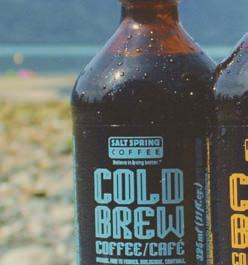
Artisan Bistro had been open for six weeks, and by 6:30 p.m. all 40 plus seats were full and the light, airy room was abuzz.
Artisan Bistro’s other neighbours were busy too. Baan Thai’s large, Broadmead location had a good crowd. Erito Sushi was busy, and there was a long lineup outside Romeo’s. But Artisan Bistro was doing more than riding Broadmead’s demographic wave of wealth and popularity.

Chef-owner Daryl Pope and sous chef Andy Campbell were producing a menu of localsourced and seasonal French bistro-inspired favourites with a unique flair.


Campbell has worked with Pope at his last three positions, most recently at The Mark in Hotel Grand Pacific. The new bistro’s subtle and creative cooking reflects their shared history at The Mark, the Victoria Golf Club and Marriott Victoria. Pope’s other previous ventures—Noodlebox and Little Thai Place—have honed his business skills, but I sensed Artisan Bistro embodies his culinary passion.
Front of house manager Nolan Wilson is a French wine scholar and an International Sommelier Guild grad with an unpretentious enthusiasm for wine. His resumé includes a recent stint as sommelier at Brentwood Bay Lodge. As Wilson worked the room at Artisan Bistro with a familial pride in the kitchen’s creations and his own wonderful wine program, he offered samples of a favourite Syrah from the Rhône Valley.
My wife and I chose a couple of Okanagan newcomers with our starters, a Riesling - Gewürztraminer blend from Oliver’s organic Covert Farms Family Estate and a herbaceous Cabernet Franc from Intersection Winery in the Golden Mile.




We shared a rich, buttery, pan-fried gnocchi with duck confit and sautéed cremini mushrooms, and Pope’s beet and pork belly salad with watercress, fresh goat cheese and candied pecans was generous enough to serve as my wife’s main dish. I had the daily special, a creamy risotto with pieces of tender, young asparagus, fresh scallops and shrimp (Nolan bragged that “everything is delivered fresh daily. We have almost no freezer space”). The dish was topped with bits of pink carnation petals, bachelor buttons and dollops of sweet mandarin orange slices. Exquisite!
Looking around the light, airy room as the night sky began to pour through the bistro’s floor-toceiling windows and doors, I noticed most diners were eating one of chef’s four burger offerings (men) or five salads (women).

I settled back in my chair as the sound system rose from quietly ambient to discernible, but still quiet, French chansons. I wished I could convince my fellow diners to expand their palates and try chef’s salmon, duck or lamb entrées. I wanted to shout, “Try the daily special seafood risotto!”
Instead, I ordered the traditional crepes Suzette with its vanilla and orange brandy syrup, mandarins and Chantilly cream ... and sighed contentedly at its heavenly sweetness, the perfect end to a perfect meal. BY

 JOSEPH BLAKE
JOSEPH BLAKE
18 EAT MAGAZINE JULY | AUGUST2016 Artisan Bistro 350-777 Royal Oak Dr.| 250-590-9333 | www.artisanbistro.ca
left: Chef and owner Daryl Pope; sous chef Andrew Campbell. right: Beet and Pork Belly Salad (watercress, fresh goat cheese, candied pecans).
Rebecca Wellman
FROM THE CREATIVE TEAM AT EAT MAGAZINE, A NEW PUBLICATION CALLED
THE EAT JOURNAL
The EAT Journal is filled with wonderful stories, unique recipes and beautiful photography.

FIND
VICTORIA
Adrienne’s Restaurant & Tea Garden
Bolen Books
Chapters Victoria Cook Culture
Fresh Coast Health Food Bar
Habit Coffee Chinatown
Ivy’s Bookshop
Lifestyle Markets
Munro’s Books
Ottavio Italian Bakery & Delicatessen
Oughtred Coffee
Only $12 at participating retail locations
Penna & Co.
Red Barn Market (All 5 locations)
The Root Cellar
Silk Road Tea
Slaters First Class Meats
Spinnakers Provisions Store
Tanner’s Books
The Whole Beast
COWICHAN VALLEY
Unsworth Vineyards
Community Farm Store
VANCOUVER
Barbara-Jo’s Books To Cooks
Cook Culture (Downtown, W Broadway, North Van)
Heringers Quality Meats in Steveston
NANAIMO
McLean’s Specialty Foods
OKANAGAN
19
Hester Creek Estate Winery THE EAT JOURNAL AT THESE LOCATIONS OR ORDER ONLINE AT WWW.THEEATJOURNAL.COM
By Elizabeth Monk
PIES, NOODLES and GREEK FAMILY MEALS
Three restaurants: two new and one worth the drive to Sidney.

Saltchuck Pies
360 Bay St at Turner St., 250.383.7551


Nick from New Zealand was missing his meat pies. Grabbing a meat pie at a gas station was part of his family’s working class culture growing up in Churchill and, great though Vancouver Island was, something was missing. And that, long story short, is how Saltchuck Pies came into being—very carefully located on Bay Street near Bridge Street so commuters can pull in and grab pies for dinner, just like back home. Nick Crooks and wife Jodie Mann certainly have the credentials to run a successful restaurant—they were the original owners of The Noodle Box. Saltchuck Pies has pies for all times of day. The breakfast pies focus

on eggs and cheese like the spinach goat cheese pie I sampled. The spinach took up the bottom half, creating a base for a very attractive whole baked egg surrounded by scrambled eggs, all baked in a pie. In a pie shop, one must have a classic beef pie, of course. The one here is made with ground beef and generous lashings of Worcestershire sauce—very tasty. There is a rotating schedule of novelty pies, which on the day I visited was a lasagna pie. Vegetarians are accounted for as well, with a delightful Moroccan Chickpea and Cauliflower Pie, delicately seasoned with coriander, turmeric, ginger, cumin and cinnamon. A variety of salads, ranging from Roast Beet
Quinoa to Spring Salad with Balsamic, and a soup of the day are available if you want something lighter than a pie. Dessert pies are more in the Canadian tradition, and Saltchuck steps up here too with a tart and fluffy lemon meringue and a peach raspberry pie with a jaunty little flower decal that brings to mind a Hello Kitty hair barrette. The best news of all—Nick Crooks doesn’t miss pies anymore.
20 EAT MAGAZINE MAY | JUNE2016 g EATING WELL FOR LESS
Nothing Beets Local Open 7 days a week FREE PARKING
eigh
clis CaaniG ,thor r rative.”arra rr
wellaldclis C
$29.95
e a o the morre adv t to mor ting with the ea star cess e o iting prro ci ough the ex thrrough w aightfor for ’ strraightf “Gianaclis “G
CP™, authorCSCalman, AMax McC —









eurwtoiis,vrettiwk & Toobecan F
ou es will guide y you ecip i d r rec arrdwar
, ent cheesess, errent cheeses ting di er afftingr raf ses of cr
heese: ing C Cheese: erringMaste ast , CP™, author ” ecipes cip ed r rec advance vanc gressing ressing o siest then prro a asiest pr

onnoisseurship fr or C Connoisseurship essons f for L

a SuliJ
hsgalortGteranks & Bh
… clear “ “
vid and Kr a avidD
akw wak etinSis
, es andd, ecip i ious r rec e …delici uctiv and instrruc $29.95


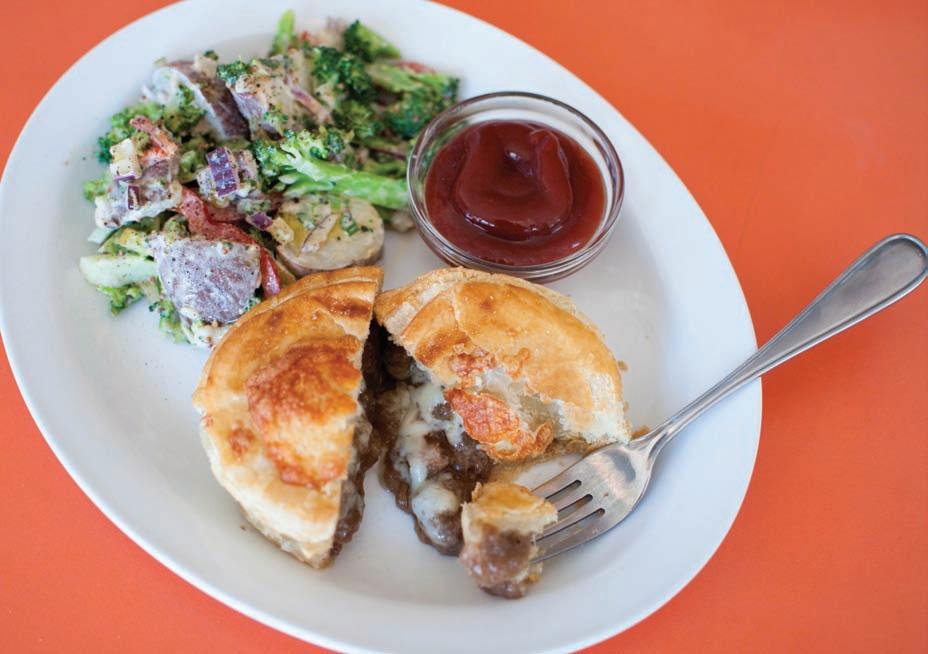
wonde wonder ormost imp
. Along with all those , manageable tantlyy, or
$29.95 US/CAN
ome on the ersonal t tome e and p omprehensive rehensiv …a c o “ “

oblem solving omotion, and prroblem , prromotion, pr tion, businesss, pr produc ro

romagerr. romager e F Fr om a Maître ship frrom Maîtr
c or mo.ctycieosw.newww e tibse
rful fr
ook , this b egetabless, uits and ve ful frruits v der
ote et t tot k our marrk elongs in y your mar b
,hieff, or in Cdit,EtapopordamRA—




ABétitppon
l

“ err. “ w ower om grro ushro ro endent m or the indep f for



oodockwLy lor a — T

Elizabeth Nyland
Chicken Curry Pie with Roasted Beet and Goat Feta Salad.
21 www.eatmagazine.ca JULY | AUGUST2016 www.newsociety.com The Ethical Meat Handbook Meredith Leigh Mastering Basic Cheesemaking Gianaclis Caldwell The Farmers Market Cookbook Julia Shanks & Brett Grohsgal Mycelial Mayhem David and Kristin Sewak Follow us on Facebook & Twitter, visit our website www.newsociety.com or call 800-567-6772 MAKE THE MOST OF SUMMER’S BOUNTY f AKE THE M M OST O F SU S B MMER’ YOUNT Y uoscinoechr t o g f fo nikoodcna c , , c y y, rehctu bmeo hetlepmCo t al Mea he EthicT hgCnikaM d FnunaeFhT ering C ero vniiv msou iere tu utcr c L tl lt e UhT armers MheFT emo t H se a at eeh fsoltanemdaund F ecudorlPansoae S l, , S aco er g FniynjooEetdiue G tmaat ookbooketCarkarmers M gnitn Planionapm Conda ofitr P un, , P r F o s
ardener rdener et G k he Marrk T The Mar , aut tierr, author ortinFJean-Mar e nar iculturre d and agrricultur oo a new f fo
o e b ositive , p full, p er f his p T This “ $24.95
Nick and Jodi Mann of Saltchuck Pies
f fo moohrsugMniworG yhem acelialMMy ofit
ok engages us in shaping
n Fw us ololoF
eighithLedMer
Restaurant and Tea House


Italian Bakery




Our doors open at 7am and our warm treats, bread and locally roasted coffee are sure to get your day started the European way.


We have been making Italian Gelato since 1999 and were the first bring this tradition to Victoria. Come and experience the freshness and texture of a product made from scratch using historical family recipes. To better serve our community we ARE NOW OPEN ON MONDAYS and look forward to seeing you all over the summer. Visit our website for historical facts and current events: Call or email us to order cakes, breads and other unique items from our offering.



Maria’s Souvlaki






When the people in the kitchen are named Maria, Pavlo and Eleftarios, you can bet you are getting real Greek food. At Maria’s Souvlaki in Sidney, this mother and her sons are cooking Greek family recipes that are generous, tasty and authentic. The food comes out fast, and the décor is simple but pleasant enough that you can linger if you want. I can never pass up a calamari starter, which is $10.95 here. It does not disappoint, being crisp and tender and flavoured with lemon and garlic. The lamb souvlaki for $9 is plump with highly seasoned lemony barbecued lamb, lots of diced tomatoes and tzatziki. The Greek salad for $5 or $10 has the classic ingredients of cucumbers, tomatoes and onions,
and the olive oil is carefully chosen from a Greek importer. The spanakopita for $6.50 tastes very fresh and the phyllo is tender and flaky. But even though I enjoy the great big wraps and pies traditional Greek cuisine is famous for, what I most enjoyed at this restaurant were the dips. The tzatziki sparkled with fresh garlic, the hummus was chunky and even meaty, and the taramasalata was made with fish roe and whipped potato, not the shortcut version of sour cream, and was light and delicate. The menu strays just a little into the realm of fries and onion rings, and I strayed right along with it. I must say the waffle fries are delicious too.
22 EAT MAGAZINE JULY | AUGUST2016
9812 Second St. near Beacon Ave., Sidney, B.C., 250-656-9944
Elizabeth Nyland
At front: Lamb Souvlaki. At back: The Calamari starter.
Italianbakeryvictoria.com *250-388-4557 * Quadra@Tolmie MONDAY TO FRIDAY 7-6, SATURDAY 7-5:30 For Reservations call 250-381-3456 | 309 Belleville Street, Victoria, BC Huntingdonmanor.com | Facebook @ TheGatsbyMansion
serving a wide selection of TWG Specialty Teas. Traditional Afternoon Tea, West Coast Afternoon Tea. t n nt a a an r ra u ur a au t ta s st e es R Re a H Te d T n nd t an e s se u us o ouHo noramondngitnuH 05l2lascnoitavreserRFo onisnaMybstaGhe T @koobeca F |moc.nor ci,VteerteSllivelle9B06 | 3543-183-0 on C,Bairot
Proudly
Ox King Noodles

Iris the International Student, an important resident of my home, is from Beijing, and she tells me that Ox King is offering authentic Chinese street food, noodles and soups. She is excited that they are here in Victoria, which is probably all our loyal EAT readers need to know, but I will offer details nonetheless. The Braised Beef for $12 was the best cultural surprise because to me “braised” connotes hot, and it is actually a delicious cold dish: a mound of shredded cucumber embraced by thin slices of beef braised in 30, yes, 30 spices, all sitting in a soy-chili sauce (the chili oil is made on site). Beef brisket reappears in the Szechuan-style beef noodle soup for $9.50, but this time cubed with the bone in. The bok choy on top of the soup is beautifully steamed—wilted yet toothsome—and the final accent is a green bean pickle, like a Chinese kimchi. Dan Noodles for $9.50 are also super-tasty. Egg noodles are tossed with sautéed sauerkraut, ground pork and a sesame sauce. Ox King also has two hot pot stations, and, to my double surprise, Hot Pot for One and Hot Pot to Go. Hot pot is traditionally a symbol of collectivist culture, in which a group or a family dip meats and vegetables into a pot of boiling stock, but Iris tells me that lately all the rage in Beijing is hot pot for one catering to men working long hours. Ox King works well for snacks as well as meals—there is barbecue meat on skewers and traditional dumplings. By detailing all the food, I have made it sound like a restaurant, but it actually looks more like a snack bar with its two tables and five bar stools. Find it near the Hudson Market, on the other side of that weird parking alley where no one knows which direction to drive (across from Olive the Senses).
Monte Creek Ranch Winery A Taste for Adventure

Monte Creek Ranch Winery's main building is made up of a tasting room and production facility. Concrete, Squamish birch, glass and galvanized metal are the main materials used in its construction. This iconic building is a futuristic throwback to the Mission, frontier-type of building style. It is meant to represent a place of gathering.
Now into their second summer, the team at Monte Creek Ranch Winery is excited to offer visitors even more. From its gorgeous position over looking the South Thompson River, only a few minutes east of Kamloops on the Trans Canada Highway, Monte Creek Ranch offers stunning views and quality artisan products.
Enjoy A Taste for Adventure in this rugged, authentic and captivating atmosphere. Get behind-the-scene knowledge of the wine production process at the winery with a guided tour. For the summer of 2016, Monte Creek Ranch is offering a tour program that provides an interactive experience, which allows you to explore their ranch, cellar and tasting room. Learn how they develop award winning wines that are true to the region.
Monte Creek Ranch is also a working ranch with a commitment to local agriculture. During the tour program, you will catch a glimpse of what ranch life is like. You’ll discover their grass-fed, grass finished Black Angus cattle, a prosperous bee colony, and acres of nutritious Haskap berries. You can expect a true farm to table experience.
There are other various programs that happen at the ranch throughout the summer. You can participate in their Sweat & Sip, Stretch & Sip or Art in the Vineyard programs. On weekends spend part of your day in a bootcamp or yoga class, that is followed by a locally inspired lunch and wine tasting. Or express your artistic side by taking an art class. You can also enjoy lawn games, a vast picnic area, a full-service lunch menu on the Terrace and much more when you visit. Take a break from the dusty trail and connect with the natural surroundings by stopping in at Monte Creek Ranch Winery. Just a 10-minute drive outside Kamloops City limits, the ranch and winery aim to follow in the footsteps of the area’s early explorers. Come experience the beauty that first brought these pioneers out West, while exploring the next frontier in winemaking.
250-573-5399
2420 Miner’s Bluff Road, Monte Creek, BC (Just a 10 minute drive outside Kamloops City limits) info@montecreekranch.com montecreekranchwinery.com
23 www.eatmagazine.ca JULY | AUGUST2016
EAT SPECIAL PROMOTION
140-780 Fisgard St., behind the Hudson Market | 778-967-1022
Elizabeth Nyland
Beef at Ox King Noodles
Braised
Seaweed Season
BY CINDA CHAVICH
SEA
VEGETABLES ARE AMONG THE MOST NUTRITIOUS
PLANTS ON EARTH—and we are literally swimming in the stuff. Go out to almost any island beach at low tide and you’ll see electric green sea lettuce and dark purple laver clinging to the rocks, fronds of frilly brown alaria (a.k.a. wakame), and salty sea asparagus at the high water line. Vast forests of kelp shelter small fish and other ocean life just offshore, and their wide flat blades and bulbous floats are often found washed up on the sand after a storm.
For the uninitiated, it can all seem like little more than a tangle of salty flotsam to navigate around on your beach walk. But for experts like marine biologist Amanda Swinimer, it’s a tasty and healthy harvest.
“We have 650 species of seaweed on our coasts,” she says, “and 32 types of kelp, the most diversity on the planet.”
AN OCTOPUS’S GARDEN
“This is rockweed, the dandelion of the sea,” says Swinimer, clipping off the forked sacs from the mats of leafy seaweed (also called bladderwrack) in the intertidal zone where we’re standing. “It’s prolific and loaded with sodium alginate, a substance that draws toxins and heavy metals from the body.”
It’s also delicious, she says, simply sautéed with a little ginger and tamari, just until the pouches turn from khaki brown to bright green.
We’ve come to the rocky end of Muir Creek Beach near Sooke, one of the spots where Swinimer forages for a variety of wild sea vegetables for her line of Dakini Tidal Wilds products that you’ll find at local groceries and health food stores. Bags of handharvested and dried winged kelp (wild wakame), sea kelp, laminaria (kombu), and kelp mixed with citrusy spruce tips and wild mint in her Land and Sea Tea are all foraged in the cold, clean waters north of Sooke.
Swinimer also offers educational seaweed workshops and guided snorkel tours through the magical Pacific Northwest Kelp Forest— a way to observe the undulating “tidal dance of massive kelps and myriad creatures that make this underwater jungle their home.
“They are the forests of the ocean,” she says, “home to thousands of fish and crab. I even saw a couple of octopus last season.”
An estimated 650,000 tonnes of wild kelp grow along the province’s coast, with bull kelp being the fastest-growing seaweed on earth, growing from a tiny spore to a 61-metre plant in a single summer.

SEAWEED TRADITIONS
Various cultures have traditionally consumed seaweed—in China and Japan, Iceland and Norway, Ireland, Wales and Nova Scotia. While creative west coast chefs have been incorporating seaweed into their cooking for some time, most Canadians aren’t really
g EAT LOCAL
familiar with eating sea vegetables at home. But all that’s changing as more people learn about the health benefits of this wild food.
Seaweed provides a wealth of nutrients, from natural vitamins A, B, C and E to potassium, zinc, iron, iodine, high levels of fibre, and, of course, the elusive fifth flavour, savoury umami.

“They each have very different textures and taste different, but they all have the umami,” says Swinimer. “Seaweed is the epitome of that flavour.” Which is another reason it’s long been a flavouring agent in traditional Japanese cuisine.
“Cooking with seaweed is such a natural thing for me,” says Takashi Ito, executive chef at The Inn at Laurel Point in Victoria. “I grew up in Sendai, in the Miyagi prefecture in Japan, where both oysters and seaweed are all around.”

Traditional Japanese cooking incorporates seaweed, from wakame in the dashi broth for miso soup to the sheets of nori used to roll rice for maki sushi, or the toasted seaweed sprinkled over cold soba noodle salad. But in Ito’s kitchen, seaweed morphs into a variety of dishes, from his deep-fried, deconstructed sushi with sesame seaweed salad, to the tender, brioche-like rolls in the bread basket, crackled with a savoury powdered Ao Nori and sesame topping.
“In Japan, we make wakame, or seafood ramen, and use kombu with rice or noodles,” says Ito, “I like julienned kombu, quickly braised with soy sauce and sugar, or sautéed in butter with a little smoked bacon and a touch of soy.”






Coastal First Nations knew about the benefits of consuming seaweed, too, layering the spring harvest of protein-rich black laver or nori (porphyra) with oolican grease to preserve it, and using the heavy stipes of bull kelp to weave baskets for food vessels and storage.

HIP HEALTH FOOD





















Seaweed landed on several top ten trend lists in 2016. Some are even calling kelp “the new kale,” so it’s not surprising that it’s turning up on local menus.

At Wolf in the Fog in Tofino, chef Nick Nutting makes a popular seaweed salad that includes slivers of shredded bull kelp with crispy popped wild rice, daikon radish and sautéed shiitake mushrooms.
At Wheelies Motorcycles café in Victoria, the sesame ginger chicken sandwich comes with a side of gochujang seaweed slaw. And Be Love combines raw kale with seaweed and “dulse Parmesan” in its Caesar salad.
At Wild Mountain Food & Drink in Sooke, seaweed is just part of the wild, local pantry for chef Oliver Kienast’s creations. The menu in this comfortable space changes frequently with seasonal harvests, but on a recent visit the fat steamed clams came in an umami-rich halibut broth with slivers of kelp and foraged Japanese knotweed. “I like things to intersect, for flavours to live together,” says Kienast, describing another favourite combination of raw oysters with sea asparagus that’s been quickly pickled in carrot pickle brine, and a dusting of powdered sea lettuce. “Shellfish with sea vegetables strikes a chord, people kind of get it.”
Kienast says it makes sense to cook with seaweed here. Not only is it plentiful and easily foraged around the island, there’s a rich Japanese culture on the west coast and a tradition of cooking with sea vegetables. He buys local Dakini Tidal Wilds winged kelp and bull kelp and forages his own sea lettuce, using kombu to add a hit of umami to his bone broths or to “jump start” the kimchi he ferments. “We spend a lot of time promoting local food,” he says. “If I can pick it the same day, I get tastier food, and I can have a conversation with my community,” he says.
“Seaweed gives a dish a briny richness, and a little bitterness, and the sea beans (asparagus) have an amazing texture,” he adds. “They pop.”


Look around and you’ll see healthy seaweed in local products. At the Cowichan Pasta Company, Matt Horn has added Dakini Tidal Wild’s wakame to his stone-ground spaghetti and at Silk Road Tea, there’s seaweed and lemongrass in the minty Mermaid’s Potion herbal tea.
You’ll find seaweed in other beverages, too, from the briny Kelp Stout from Tofino Brewing, to Sheringham Distillery’s Seaside Gin, infused with Alaria marginata.
“I think it gives it a briny ocean feel and a touch of richness, or umami,” says distiller Jason MacIsaac, a former chef who flavours his gin with wild botanicals, from juniper and wild rose petals to local lavender and Dakini’s winged kelp, foraged from the ocean next door.
local, organic, and wild ingredients breakfast * lunch * dinner * staywww.sookeharbourhouse.com c, aniag r al, o or oc loc lo ngr gr d i l ld i wnc,id a ts di edi ed www.eatmagazine.ca JULY | AUGUST2016 25
“I’ve been surfing here for 25 years and in the fall the kelp beds clean the waves, just grooms it out,” he adds. “I like that idea of kelp polishing the wave out, making the surfing so clean, like the gin. We say ‘it’s clean as a south island surf’.”
GETTING THE GOODS



Summer is “seaweed season” on Vancouver Island. Anytime between May and September is the perfect time to learn how to harvest and cook sea vegetables.

You need a license to harvest seaweed commercially, but individuals are free to forage for sea plants at low tide. Swinimer says there’s an hour or so on each side of low tide for harvesting the seaweed anchored to the rocks. Bright green sea lettuce may be found floating in tidal pools while black nori (laver) will be slicked down over beach rocks and should be cut with a knife or clipped with scissors.
“Just give it a haircut,” says Swinimer, slicing off the top of a large, bronze-coloured kelp, leaving the hold-fast base attached to the rocks. Rinse each piece of seaweed well in the ocean as you harvest and put it in a bucket of sea water, she says. The smooth blades of iridescent rainbow kelp (iridaea cordata) are deep purple with flashes of blue, the wavy wakame olive green to brown, the giant bull kelp dark green and more than 10 feet long.
“Kelp grows 100 feet in six months,” she adds, noting the plant has no roots but rather a structure at its base that anchors it in place. It will live up to 25 years if properly hand-harvested.













Look for a beach with a variety of sea plants, she says. Too much sea lettuce can mean excess levels of “nutrients,” like the kind found around a sewage outfall, and should be avoided. Once harvested and washed, seaweed can be dried on screens or hung from cedar racks. Nori and sea lettuce will be dry in eight hours, says Swinimer, who has been harvesting here for 15 years, while kelp and wakame can take two to three days to dry.
WILD MOUNTAIN STEAMER CLAMS WITH KELP
Chef Oliver Kienast of Wild Mountain Food & Drink in Sooke garnishes his plates of steamed clams with wild herbs such as miner’s lettuce, mustard flowers and slivers of rhubarb-like knotweed for a pretty presentation.

26 EAT MAGAZINE JULY | AUGUST2016
SEAWEED IN THE KITCHEN
Crunched as a salty snack or rehydrated in water to add to soups and sauces, it’s fast and easy to add seaweed to the menu. Seaweed doesn’t have a lot of flavour, but there’s definitely a unique texture to these sea vegetables.
A little goes a long way. Dry seaweed swells to about four times its size when soaked. To get the most flavour from your seaweed, even sheets of nori for sushi, make sure to toast it first by heating it in a dry pan or holding it, with tongs, over an open flame.
Local chef and author Bill Jones offers lots of information about seaweed in his book The Deerholme Farm Foraging Book (TouchWood Editions, 2014), along with recipes for several seaweed dishes, from stir-fried crab with spicy seaweed sauce to seaweed pesto, seaweed béchamel and Thai-flavoured spot prawn and seaweed bisque.
Jones also makes an Asian seaweed sauce, a puree of boiled fresh or dried seaweed seasoned with miso, soy sauce, mirin and sesame oil, that he says can be frozen to add to stir-fries and chowder, or served with poached halibut.
To make seaweed powder, just grind dried kelp in a spice grinder and store in a glass jar. Jones uses seaweed powder in several recipes, from béchamel sauce to pasta. It makes a great salty addition to buttered popcorn, rice or breakfast eggs.
You can buy dried nori, wakame and kombu in local Japanese and Korean markets. Look for packaged seaweed with good colour and aroma. The thinnest, most delicate nori is the finest. Some Korean nori products are flavoured with sesame oil or wasabi for snacking. You can also buy locally harvested seaweed from Dakini Wild and Bamfield’s Canadian Kelp Resources at stores like Market on Yates and Lifestyles Market, where Swinimer’s dried kelp is sold both packaged and in the bulk bins.
A HEALTHY SNACK

You don’t need to eat a lot of seaweed to reap the health benefits—all you need is about five to 15 grams of dried seaweed or a few sushi rolls a week.
As seaweed is naturally adapted to drying out in the sun when the tide is low, then rehydrating as the tide comes in, it’s considered a “live food” whether fresh or dried. A single sheet of nori has less than 20 calories and no fat, but about 300 mg of sodium. High in iron, iodine, fibre, protein and B vitamins, kelp is antibacterial, antiviral and anti-fungal, says Swinimer. But kelp can also concentrate heavy metals so must be harvested in pristine waters. Canadian supplies are tested regularly, says Swinimer.

TYPES OF EDIBLE SEAWEED
Most people will recognize the sheets of nori used to wrap their sushi rolls, but there are many different kinds of seaweed. Here’s a primer:
Bull kelp is salty and slightly sweet, with a fine tender texture and green colour. Reconstitute or serve fresh in salads or lightly cooked. It’s the giant kelp with long flat blades, thick stipes and bulbous floats you’ll find washed up on the beach or in offshore forests.
Winged Kelp or alaria is a ruffled brown kelp with a chewy texture when reconstituted. Perfect to cut into fine ribbons to add to kelp salads. Also common on the east coast and Britain.
Sea Lettuce or green laver is electric-green, very delicate and usually found floating in tide pools at low tide. Eat it fresh or dry in a 200°F oven (or dehydrator) and crush to a powder.
Laver or porphyra is also called purple laver or wild nori. Its thin short blades can be found clinging to rocks on the beach, draped over boulders in thick dark mats. Laver is the seaweed used to make Welsh laverbread, a puréed paste served on toast.
Wakame is a green, satiny seaweed that’s slightly sweet and used in miso soup and seaweed salads. Soak in water for five minutes to rehydrate and cook lightly to tenderize, then dress with soy sauce, sugar and rice vinegar.
Nori or pyropia is sold in sheets in Japanese and Korean markets for making sushi. Nori may also be flavoured with soy sauce, sugar and sesame oil for snacking. Nori softens when rolled with rice but can also be toasted in a hot, dry pan to soften and heighten the flavour.
Kombu is a type of kelp (Laminaria) cultivated in Japan and Korea and sold dried in large sheets or shredded. Combine with bonito flakes to make dashi broth, add to rice to season while cooking, simmer for 30 minutes to soften for salads, or toast and crumble to use as a seasoning. Add kombu to a pot of beans while cooking to make them more tender and digestible.
27 www.eatmagazine.ca JULY | AUGUST2016
Clockwise









Dinner: Tuesday – Saturday 5pm till late









Brunch: Saturday & Sunday 10 – 2pm Closed Monday


FROM AN HERBACEOUS CHIMICHURRI TO A FRUITY MANGO CHUTNEY to the exquisite simplicity of sea salt flakes and freshly cracked pepper, condiments have added sparkle to the snacks and meals of the world’s tables for centuries. Condiments elevate and enhance, add colour or fire, nutrients, umami and brightness. Without them, meals would be bland affairs. The best way to undertake an exploration of condiments is to dig right in. Take cues from the global marketplace with a shopping trip to Fisgard Market in Chinatown, Fairway Market on Quadra and Fig Deli at Shelbourne and Cedar Hill Cross Rd. There’s a whole world to explore and experience, promising to open up our palates and refresh our tastebuds. Here are a few of my favourite flavour bombs, to hopefully spark your own journey of exploration.
SALT



Starting with the basics, salt lifts flavours out of the doldrums, heightening, lifting and accenting. In a Hainanese dipping sauce, it’s an integral, out-and-proud ingredient served alongside steamed fish or chicken. A mixture of neutral oil, grated ginger, finely chopped scallions and salt, it’s brilliant in its bold simplicity. The sauce is salty, but kept in balance with the three other ingredients. It’s easy to make at home, and I’ve used any leftovers on top of steamed rice, over scrambled eggs served wrapped around warm tortillas, or on anything neutral that needs a salty-gingery kick. Flash-fried Padrón peppers, the quintessential Spanish tapa or pintxo, would be slipshod without the last-minute hit of salt. Each summer, Chorizo & Co, who
Taking cues from global flavours, get onboard the condiment train where you can shake, slather, sprinkle and pour your way through a multitude of chutneys, salsas, pastes and spice mixes.
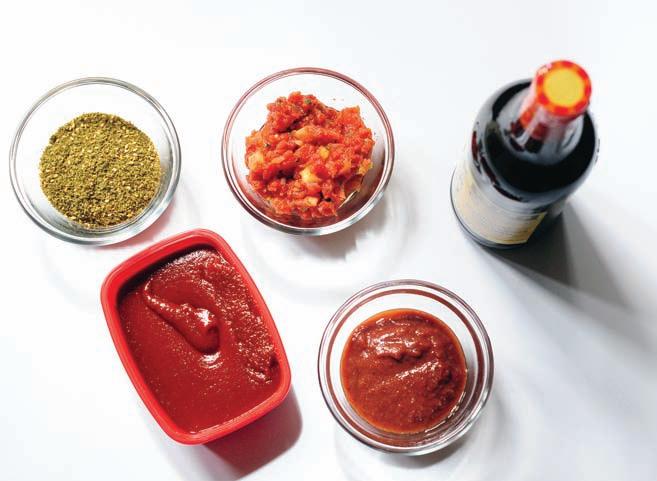


28 EAT MAGAZINE JULY | AUGUST2016
658 Herald Street – Victoria, BC www.saveurrestaurant.ca | 250.590.9251
g
GLOBAL PANTRY
Here are a few of my favourite flavour bombs, to hopefully spark your own journey of exploration.
“
from top left: Middle Eastern za’atar, Mexican salsa, Chinese aged black vinegar, Sutra’s tamarind and date chutney and Korean gochujang
STORY BY SHELORA
grow their own Padrónes, offer this amazing treat. Perhaps vying for the role as the new ketchup—along with sriracha, Korean gochujang and salsa—is the moreish and versatile Vietnamese dipping sauce called nuoc cham. It’s a delightful flavour quartet—sweet, salty, savoury and spicy—a condiment that makes a dish sing, particularly a bahn mi sandwich, pork meatballs, shrimp fritters or on the hot crackling crust of a deep-fried Vietnamese spring roll. Combining lime juice, fish sauce, sugar, chilies and garlic, it adds a sweetness, brightness and umami-ness that cuts through the crispiness of the roll, complementing the mélange of ingredients inside. It also makes a lovely marinade for chicken wings. Just be mindful of the heat when baking or grilling. The sugars will caramelize quickly and you don’t want the meat to burn.
VINEGAR




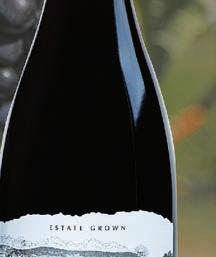








Vinegar’s prismatic array promises all sorts of flavour treats. Balsamic’s concentrated woodsy sweetness is brilliant drizzled over sautéed greens or added to fragrant olive oil as a dipping sauce for focaccia. The wonderful spicy concoctions from the Philippines add sweet, sour and spicy tang to vegetable and meat marinades in a classic adobo, and why not forget the soy sauce just for a minute and try Chinese aged black vinegar. Also known as chinkiang or zhenjiang, it has a sharp and deep flavour, and when you add in finely julienned ginger, it is the ultimate dipping sauce for dumplings, especially the soupy xiao long bao. Rice vinegar, used extensively in Japanese cuisine, adds lively brightness to salad dressings, especially with cucumbers and apples, in the Japanese sunomono noodle salad or in chicken or pork marinades.
Raw oysters, while spectacular with a hit of lemon and Tabasco, come into their own with the classic French mignonette. Roughly translated as “little lovely,” the recipe calls for red wine vinegar, shallots for sweetness, black pepper and a bit of salt. According to Jess Taylor of the Wandering Mollusk, who adds a splash of pinot noir to their mix, the sauce “never overwhelms but lets the oyster talk.”
Malt vinegar, a standard shaken over salty French fries, cuts through the hot grease with a tang. And my favourite over fries is the spicy-vinegary condiment Tabasco. At North 48, their housemade hot sauces blending fruit and chile in four heat quotients complement the richness of their braised duck wings.
CHUTNEY

Chutney, India’s vibrant kindred spirit to relish, can be created out of almost anything, especially vegetables and herbs. Their














29 www.eatmagazine.ca JULY | AUGUST2016 beyond organic Premium small lot wines from handpicked organic grapes Sage Hills Organic Estate Vineyard & Winery 18555 Matsu Drive Summerland BC, (250) 276 4344 sagehillswine.com @sagehillswine Hours of Operation: May 15 — November 1 Open Daily 11am — 5 pm Outside of these times, tastings available by appointment. ills HSOage e Srivatsu18555D M rganic Estate ills O y iner & Wi ineyard ummerland 276 4344 e peration: ours of OH ember 1voay 15 — NM aily pen DO ember 1 Condiment
Nation
SHELDAN
PHOTO BY GARY HYNES
IT’S IN OUR HANDS. HAND-CRAFTED BREAD MADE WITH FRESHLY STONE-MILLED FLOUR AND ONLY CERTIFIED ORGANIC OR SUSTAINABLY GROWN LOCAL INGREDIENTS . NATURALLY LEAVENED
BAKED TO CRUSTY PERFECTION IN WOOD-FIRED BRICK OVENS.





traditional use transforms an everyday diet of rice and dahl, and with the use of fresh herbs adds a layer of nutrition. At chef Heidi Fink’s Indian cooking classes in Victoria, she teaches the nuances of Indian cuisine, bringing dishes to life with chutneys. “They add an extra flavour dimension that complements the main dish,” she notes. “They ramp up flavour and they increase the wow factor.” Heidi’s favourite chutney hails from North India, a simple blend of fresh mint, jalapeños, green onion, sugar and lime juice or vinegar. “It’s like a party in your mouth,” she exclaims, “and it goes with a multitude of cuisines. I’ve used it on lamb kebobs, chickpeas, grilled cheese sandwiches and with yogurt in a pita.”
The mint-mango chutney at Vij’s Sutra at the Hudson Market is another party animal. Delightful with pakoras and curries, I’ve dished it up at home on damn near everything, including Baja-style fish tacos, for an India-meets-Mexico fiesta. Chutneys also become lively dipping sauces when mixed with a bit of mayonnaise or yogurt, excellent on a burger.
HERB PASTES

Herbs feature large in chimichurri—the parsley, oregano, garlic and oil condiment of Argentina, an essential addition to their meat-centric diet. A wonderful version can be enjoyed at the Penticton Farmers’ Market, where A Taste of Argentina makes a robust version to complement their choripan, essentially a chorizo on a bun. Who can’t resist the pungent blast of basil in an Italian pesto with pine nuts and Parmesan, or the French version, pistou, dolloped into soup? Morocco’s herbaceous chermoula, with garlic, lemon, smoked paprika and often cumin seeds can be added to stews, makes a wonderful marinade and is brilliant slathered over roast chicken.
SALSA
























Like chutney in India, no meal in Mexico is complete without the addition of salsa. They, too, can be made with myriad ingredients and prepared smoked, roasted, boiled or fried, grilled or fresh, made with dried or fresh chilies, one variety or several, explosive with heat or not, with fruit or even wild foraged ingredients such as roasted gusanos (grub worms). They can be as simple as a bright and smooth salsa of blended jalapeños with a bit of oil to a grilled and roughly chopped pineapple and serrano chile salsa for fish, to a toasted ground salsa of arbol chilies, salt and oil, reminiscent of the ground chile condiment seen in Chinese and Vietnamese restaurants. I’ve enjoyed them all, including the one with gusanos! My favourite at home is an everyday-everyway salsa made with readily available tomatillos, pulsed in the blender with a jalapeño, half an avocado, a bit of garlic, cilantro and salt to taste. It’s tangy, creamy and bright, and I use it on fish, queso fresco, any kind of barbecued meats, on tacos, a hot tortilla or just scooped up on chips.
Salsa, as we know, has become a loosely used term, but don’t let worries about
















































30 EAT MAGAZINE JULY | AUGUST2016
1517 QUADRA ST. Beer Gardens Live Music Artisans Food Trucks gourmet food Workshops
oaklands.sunset.market OaklandsSunsetMarket @OaklandsMarket community association AtOAKLANDSCOMMUNITY CENTRE:#1-2827BELMONTAVE www.oaklandscommunitycentre.com/markets SMu e k n eeer s ns t seet t etunnseset ark Mark Mararkeket e et t et MaarrksM dssM d annd a klla k Oaak O s ndds n an a klla k oaak o wo w. w ww w ww w a n t k a unniitty y asso o occiaatioon y yc c ceen @ @O n tassocia l a r Oa O oa sc c co coomm mm m u o @OaklandsMark nsse n SuunsS annddssS a klla k ak a n u se l d OaklandsSunset n e suunnsses.s s ds d annd a klla k ak a .s n uns s oaklands.sunset M M LM L EL E BE7B 277B l C CE E ENNT .o tion nititty associa o om m mmmu u un n ni m t d www.oaklandscommunitycentre. TR 82 2 2 28 8 E:# REE:# R -211 CENTRE:#1#1-2827BELM A SC MM M OM O CODSSC D ND At AKtO t LA L KLOAAK O N AN A AtOAKLANDSCOMM m Ma t et e ke UN N ON O MO re r tr t nt a ma MU ardens arrket TAVVE A s etskeet k comomm//mma coec s ucck u ru r T sa isa is tisArrtti A G c ic sic si n an
ar a ar ts M rk ou f fo o ork
B e Be Artisan Mu d us u W Wo L g ve v iv Liv Li o mar F go k u gou ruck o oo et ket t E NT ark ark N t. ket t NIT NI r kets tre r e.com/mar MONNTAVE U TY ITY Y NITY ns k oood s sh ksh kshohopops ps s d met r
AND
Sunset Market
s ns ensrdedeen rd ard
er
authenticity stop you. They can be thrown together at a moment’s notice with any kind of ingredients. For a Mediterranean feel, try cucumber, tomatoes, red onion, red pepper, lemon or lime juice, salt, a bit of cilantro or parsley—it’s all good.
For inspiration on salsas and other condiments, I often consult the book, Salsas, Sambals, Chutneys and Chowchows by Chris Schlesinger and John Willoughby. It’s a fun little tome of 40 diverse recipes, little dishes that skirt the globe to dress up any meal. I’ve made their mango-jicama relish with habaneros, a salsa of sorts, countless times, served with grilled tuna steaks.
SPICE BLENDS
Beyond the chutneys and salsas, spice blends also add that certain je ne sais quoi to a profusion of plates. Japanese gomashio, a ground mix of sesame seeds and salt, and often toasted nori, is delicious over brown rice with scrambled eggs or over steamed greens with a hit of soy. In the same vein, dukkah, of Egyptian origin, sees various guises of toasted ground nuts, seeds and herbs giving flavourful life sprinkled over warm lavash or pita with yogurt, honey and a drizzle of olive oil. It also adds depth sprinkled over hummus, or as a dipping spice for a platter of crudités, especially carrots and cucumbers. The aromatic duo of Middle Eastern za’atar and North African ras al hanout spice mixes add warmth and depth to any kind of savoury dish, from rice pilafs to tagines to salads, pickled vegetables and yogurt. Ras al hanout sprinkled over French fries at Part and Parcel is an unlikely pairing, but it works, addictively so. I’ve experimented using the spice blend over scalloped and baked potatoes at home. Both were delicious. And recently, I enjoyed fries at an Indian chaat (snack) house in Surrey, seasoned with garam masala, a not-too-distant cousin of ras al hanout. The blending and mixing of cuisines is an exciting aspect of playing around with condiments, and I encourage you to create your own experiments and culinary mash-ups. Let your palate be your guide.
SWEET OBSESSIONS Just
Opened

Parachute
Located in Victoria’s newly hot industrial district, Parachute Ice Cream Parlour is an off-shoot of the popular Victoria Pie Co. in the Hudson Market. Owner Robyn Larocque creates unique flavours like Browned-Butter Brownie and Lemon Cream (made with water buffalo milk). 105-2626 Bridge St, Victoria


La Roux Patisserie

Everyone needs more pastry in their life and La Roux Patisserie delivers. Just up the street from Olo in Chinatown owners Rebecca Goudin and Emily Hatlelid fashion delicate French pastries with a twist. We devoured the Black CurrentElderberry Silk Road Tea eclair! Look for macarons, pies and carrot cake among the many pastries available.
519 Fisgard Street, Victoria
Kid Sister
Beloved Victoria favourite Kid Sister has relocated to Chinatown’s Fan Tan Alley. Flavours like Grapefruit & Apero and Mango Raspberry Lime will brighten up your day. 10 Fan-Tan Alley, Victoria
31 www.eatmagazine.ca JULY | AUGUST2016

FROM THE CITY TO THE
Farm
Life, labour and love at Ravenhill
By Jill Van Gyn Photography by Rebecca Wellman
I DROVE MANICALLY ALONG MT. NEWTON CROSS ROAD hoping I wasn’t going to be late for my meeting with owners of Ravenhill Farm Brea Segger and Todd Howard. Moments before I stepped into the spacious farmhouse I had been yelling into my Bluetooth trying to fix some last-minute chaos and battling sweat and disarray after a long day of work. As I stepped over the threshold, all the bedlam of my daily life fell away as I was greeted with a cool, herb-scented breeze, two blond-haired, barefoot toddlers and broad smiles from both Brea and Todd. An enormous island, haloed by hanging cast iron and copper pans, dominates the open, country-style kitchen. Bunches of dried lavender adorned the walls, cookbooks and gardening almanacs filled every available shelf, and large glass urns of Kombucha ferment on the countertops. This was not a curated farmhouse kitchen meant for the pages of an overly designed home journal. This was a wonderland of family, cooking, social activity and farm life. Well-lived in, well-loved and wellused.

Everyone in the household was barefoot, and after being encouraged to release my feet from their prison of dark dress socks, my transformation was complete—I was now a version of my former self: relaxed, carefree and unbounded by earthly matters. Ravenhill has this effect on people. Perched high on a south-facing hill, the spring sun beats down on unending gardens and pastures ringing with the sound of pollinating bees and sprouting plants. The bright, flora-abundant farm sets one
at ease immediately and forces you to focus only on the smells and sights around you. Brea and Todd have this effect on people, as well. The young couple, who are also partners in Victoria’s Pacific Rim College, specializing in integrative and complementary medicine, are warm, easy-going and seemingly untouched by the pace of technology and urban disorder only a few kilometres away from them.
After peeking into a cloth-covered bowl, where a pool of golden honey was forming under a perch of comb, I was escorted onto a stone patio ensconced in unruly herb bushes, wisteria and the shade of overhanging trees. Todd had laid out a spread of homemade goat cheese, hummus and seed crackers as Brea picked sweet cicely and mint to add to a honey-water elixir. I had entered the Secret Garden and I was never going to leave.
Brea and Todd are the type of people you ought to be jealous of, but any bitterness is edged out because you are just so damn happy for them and the idyllic life they have worked so hard to achieve. Born in the U.S. the Appalachian Mountains, Todd was a self-declared vagabond who had trained in Chinese medicine in Sri Lanka and China and attended no less than six universities and colleges. One day he decided to hop on his bike heading north and landed in Victoria where he knew he had found a home. After setting up Pacific Rim College in 2006, he travelled to Zanzibar to oversee a foreign practicum program where he met Brea, a Cowichanborn merger and acquisition manager who had left her Vancouver high-rise and
33 www.eatmagazine.ca JULY | AUGUST2016
FACING PAGE: TODD HOWARD WALKING ALONG THE MAIN PATH THROUGH THE HERB GARDEN. ABOVE: BREA SEGGER IN THE GARLIC FIELD.




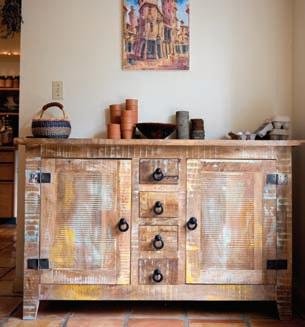


34 EAT MAGAZINE JULY | AUGUST2016
flashy high heels behind for work in the non-profit sector. “I instantly fell in love with her. I had a business that needed to be audited and Brea was looking for a change in life, so I invited her out to Victoria and it took off from there,” remarked Todd as he and Brea smiled at each other. Somehow these two found each other on a remote island in the Indian Ocean, only to settle down back on the West Coast to run the college and work on their dream of living off the land and off the grid. When you meet two people who are essentially the basis for a Nicholas Sparks novel, you are required to instantly fall in love with them. While they ran the college, Brea continued to pursue her passion for growing every variety of fruit and vegetable she could on the rooftop patio of their Vic West condo. Brea had managed to grow 18 different varieties of tomatoes, lime, lemon and cherry trees, and at one point even had a row of corn. “Our neighbours used to call us Little Italy because we had so much fresh food growing,” quipped Brea. Finally, the limited space started to restrict her ambitious projects, and the couple readied themselves for the jump from city to farm.
Brea and Todd had very limited “country-life” experience, and the first two years at Ravenhill have been pretty touch and go. The couple relied heavily on YouTube, a small library’s worth of books and advice from experts who were willing to part with their secrets. Brea recalled that within 48 hours of moving to the farm, she had arranged to adopt 20 aging chicken to roam free-range. With no chicken-rearing experience, they ran into a few problems along the way: “We would find chickens in all sorts of interesting places, including regularly wandering through our house. Many of them chose not to lay in their nesting boxes. This meant everyday presented us with a new egg hunt! Occasionally we would find a huge cache of 20 or 30 eggs in one location, such as under porch stairs, at the base of a hops vine and in planters outside our front door. It didn’t take us too long to enclose the chickens in 2.5 acres instead of 10 acres, where 85 or so chickens continue to happily free range on today.”

Ravenhill Farm is a storied parcel of land that breathes heavily of Vancouver Island history. Built in 1912, the property has changed hands many times and rings with old Victoria names such as Westinghouse and Thomson, even passing through the ownership of Colonel Douglas in 1928. The culinary history of the landmark really began with food writers and farmers Noel Richardson and Andrew Yeoman. The married pair cultivated an enormous and prosperous herb farm, spent their time writing an anthology of cookbooks based on the plants and herbs grown at Ravenhill and held cooking classes and workshops in the expansive kitchen and dining area. Brea and Todd are carrying on the tradition of a commitment to food, learning and social connection. “We always have company over,” says Todd. “This is a very social environment, and many times our guests have been in that very kitchen as guests of Noel and Andrew.”
Todd has become an adept and adaptive chef in response to Brea’s passion for growing amazing food. “Eighty percent of our meals come from the farm. We decide every meal by just walking out to the garden to see what needs to be harvested.” The couple are working on creating a supply of abundant and interesting crops to provide for themselves, farmer’s markets and, one day soon, local restaurants. The ambitious project includes a vast nut orchard, exotic fruits such as kiwi, pomegranate, goji berries and citrus, and an array of B.C. heritage produce. Grains, such as amaranth and quinoa, are also on the menu, along with corn to ensure that Todd continues to serve his family favourite—polenta. Moving forward Brea and Todd also hope that they will be able to produce medicinal herbs to supply the dispensary at Pacific Rim College.
Ravenhill Farm is in the best of hands. Watching the sense of ease, excitement and passion in the faces of the young family as they talk about the farm and their plans for the future assures me that Victoria will soon be the recipients of some beautifully and thoughtfully grown food. The move from city to farm may not be for all of us, but for Brea and Todd it appears that this is where they were always meant to be.
35 www.eatmagazine.ca JULY | AUGUST2016
BACKYARD BBQ MENU



Oh, Spare Me!
Serious rib lovers choose St. Louis spares. Basically they’re really meaty and super fatty spare ribs. They’re taken from the bottom of the ribs, on the side of the belly of the pig, so they’re way bigger, meatier and more toothsome than the tiny, baby back ribs. Because these are so rich, round out the meal with lots of greens. A big salad of grilled broccolini fits the bill.
36 JULY | AUGUST2016EAT MAGAZINE MARCH | APRIL2016 LOCAL KITCHEN g
St. Louis Ribs
Grilled Broccolini Salad
Blueberry
Mascarpone Tarts
Fava Bean Bites
SERVES 6
WINE Averill Creek Somenos Rosé 2015 (Cowichan Valley)
Pair with a glass of rose for an easy summer starter. Look for smoked ricotta if you can find it. Divine.

21⁄2 cups shelled & peeled fresh fava beans
1 cup ricotta cheese
1⁄2 cup grated Parmesan
1 tsp sea salt
Toasted baguette slices
Coarsely chopped fresh mint
Gently boil beans until tender, then drain and cool in an ice bath. Place in a food processor. Add cheeses and salt. Puree until as smooth as you like. Taste and add more salt, if needed. Spread on slices of toasted baguette and top with mint.
TIP: No fava beans? Sub in cooked peas or 2 cups pureed cooked carrots or beets.
St. Louis Ribs
SERVES 6
BEER Deschutes Black Butte Porter (Oregon)
Better have a cold beer handy – these ribs are spicy with subtle undertones of caramelized sweetness. Use your favourite beer for the sauce, although a delicious stout works pretty well! For best results, prep ribs and sauce a day ahead so flavours blend, and then finish on the grill just before serving.
3⁄4 cup palm sugar
3 Tbsp sea salt
3 Tbsp smoked paprika
2 Tbsp cayenne pepper
2 Tbsp garlic powder
2 Tbsp dried oregano leaves
1 Tbsp ancho chili powder
3 slabs St. Louis-style pork ribs
1⁄3 cup grainy mustard
1⁄2 cup butter
650 ml beer, preferably stout
Fava Bean Bites
Mix sugar, salt, paprika, cayenne, garlic, oregano and ancho chili powder together. Set 3 Tbsp aside for later. Pat ribs dry with a kitchen towel, then lightly spread mustard over both sides on each slab.
Generously coat with spice mixture and rub in. (Save any leftover rub for another day.) Wrap each rack in foil and tightly seal edges. Place on a baking sheet (use 2, if needed) and bake in preheated 325°F oven until meat is fork-tender, about 21⁄2—3 hours. Let cool.
Melt butter in a saucepan over medium heat until brown and foamy. Carefully open one end of foil on each rib packet. Pour all the juices into pan. Add beer and reserved spice mixture and simmer, stirring often, until thick and saucy. This may take a while, depending on the size of your saucepan. Don’t be surprised if takes 30-40 min. If making ahead, wrap ribs and sauce separately. Once sauce has cooled, it’s easy to scrape off the layer of fat. Refrigerate up to 3 days.
When ready to serve, prepare grill and set to medium high heat. Grill ribs, turning and basting often with sauce, until lightly charred. Let racks rest, and then slice into smaller portions.
Grilled Broccolini Salads
SERVES 6
Broccolini is a hybrid of broccoli and Chinese kale. It has a sweeter taste than broccoli, but still has that trademark cabbage-esque bite. Tastes best hot of the grill.
4 bunches broccolini
Olive oil
Sea salt
1 shallot
1 pint colourful cherry tomatoes
1⁄2 cup crumbled feta
2—3 Tbsp good quality balsamic vinegar
Trim and discard bottom tips from broccolini stems. Generously drizzle with oil then toss with pinches of salt. Set aside while the barbecue heats to medium-high.
Meanwhile, thinly slice shallot and cut tomatoes in half. Place in a serving bowl and lightly sprinkle with salt and drizzle with a little olive oil. Let stand while grilling broccolini.
Grill broccolini, turning often, until lightly charred, 4 to 6 min. Add to bowl with tomatoes. Drizzle with vinegar and toss to mix. Taste and add more vinegar, if needed. Serve warm.
Blueberry Mascarpone Tarts
SERVES 6
Similar to cheesecake, this is an easy, no-bake summer dessert that’s light and refreshing, yet deeply satisfying. Swap blueberries for other berries or seasonal fruit.
3 cups chocolate wafer crumbs
3 Tbsp finely chopped basil
2 Tbsp cocoa
1⁄2 cup butter, melted
Six 4.5” fluted tart shells with removable bottoms.
4 cups blueberries
1 —2 Tbsp orange flavoured liquor
Two 475 g tubs mascarpone cheese
3⁄4 cup icing sugar
2 large lemons
1 Tbsp vanilla extract
Torn fresh basil leaves, optional
Pulse chocolate crumbs, basil and cocoa powder in a food processor. Turn into a bowl and stir in butter. Divide mixture between tart shells. Firmly press into bottoms and up sides. Save any leftover crumbs. Refrigerate until chilled, and then place on a baking sheet. Bake in preheated 350°F oven for 10 min. Cool completely on a rack.
Meanwhile, toss berries with orange liquor and set aside. Stir cheese with icing sugar. Finely grate in peels from lemons and then squeeze in juice. Stir in vanilla. Evenly divide mixture between cooled tarts and top with berries. Garnish with fresh basil.
RECIPES 37 www.eatmagazine.ca JULY | AUGUST2016
RECIPES & FOOD STYLING BY JENNIFER DANTER PHOTOGRAPHY BY MICHAEL TOURIGNY
Local List Guide
DUNCAN
HUDSON’S ON FIRST
Award winning dining in a beautifully restored heritage home. Local ingredients, classic techniques and made from scratch cooking are a just few reasons to visit us in Duncan more often. Celebrate Bubbles & Brunch, Lunch and Dinner.

163 First St. Duncan, BC, 250-597-0066, hudsonsonfirst.ca

DUNCAN GARAGE CAFE & BAKERY
Join us this summer for fresh new salads, wraps, and smoothies and home-made ice cream sandwiches. Don't forget the 39 days of summer. Music every day from end of June to beginning of August. Great food using local and organic ingredients. Busy, Happy, Funky and welcoming downtown vibe. Open 7 days/week.
330 Duncan St., Downtown Duncan (across from the railway station), 250-748-6223


SALT SPRING ISLAND
HENRI PROCTER REALTOR
New kitchen, new home? Henri is an award winning Realtor, serving Saltspring for 30 years. Positive, friendly and professional, Henri will excel in finding your perfect match.
Henri Procter, MacDonald Realty, 250.537.1201, henriprocter@gmail.com
101-170 Fulford-Ganges Rd., Salt Spring Island, realtysaltspringisland.com


FERNWOOD ROAD CAFE
A funky little café with an incredible view, great coffee and lots of home baking - for breakfast, lunch and dessert.
Summer hours: 9am-5pm, 7 days a week.
325 Fernwood Road, (just across from Fernwood dock, north end) Salt Spring Island, 250-931-2233, fernwoodcafe.com
MATTICK’S FARM

ADRIENNE’S RESTAURANT & TEA GARDEN
Come in and experience our Restaurant & Tea Garden. We offer daily specials that feature local and fresh items. Enjoy the sun on our outdoor patio these upcoming months, and feel free to make reservations by giving us a call!

We are open daily for Breakfast, Lunch and Afternoon High Tea in our Restaurant, Deli, Bakery and Ice Cream.
5325 Cordova Bay Road, Victoria, BC, 250-658-1535, AdriennesTeaGarden.com
VICTORIA PUBLIC MARKET WHISK

Whisk is a fully stocked kitchen shop nestled in the middle of the Victoria Public Market. Fiestaware, bright linens, gadgets, cards and cookware are just some of the reasons to visit, and it always smells delicious in here! Wedding registry available. At the Victoria Public Market, 778-4339184, whiskvictoria.ca, Facebook and Instagram. Open 7 days a week
SPECIALTY FOODS RED BARN MARKET
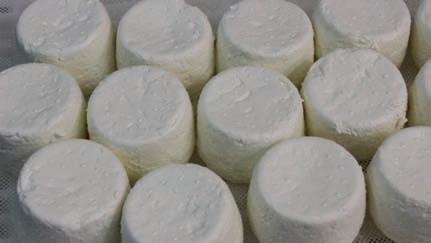

Red Barn Market is an Island Raised and Island Owned Company. We believe in providing our customers with locally sourced, top-quality products and produce. Try our specialty line of smoked cheese & smoked meat products!
West Saanich, Mattick’s Farm, Vanalman, Latoria Walk & Oak Bay. www.redbarnmarket.ca
38 EAT MAGAZINE JULY | AUGUST2016 Victoria Public Market 778 433 9184
A Day at Yonni’s Doughnuts
by Jill Van Gyn
IMAGINE YOU SET YOUR ALARM FOR THE CRACK OF DAWN. You wake up because it is time to work. Maybe you push papers, or fix broken machines. Maybe you’re a spreadsheet master, or take customer complaints by phone. But imagine for a moment you are Jessica MacKinnon and you wake up to mounds of fluffy, deep-fried dough and a palate of flavour creations at your fingertip. Now that is a reason to set your alarm and dive headfirst into the workday. MacKinnon is the head baker at Yonni’s Doughnuts. At the ripe old age of 25, she is in charge of bringing you the endless joy you feel when you pick up a doughnut at Discovery Coffee.
I arrive at Discovery Bakery in James Bay, home of Yonni’s Doughnuts (named after Discovery owner Logan Gray’s father) at 9 a.m. on a Saturday. MacKinnon greets me warmly, flanked by two other bakers, Erin Shotton and Jessica Galpin. In truth, I thought the best I would get was a chair in the corner where I would sit quietly taking notes so as not to interfere with the doughnut-making process. I was wrong. From the get-go I am expected to get elbowdeep in dough and sugar, and I am all too happy to oblige. MacKinnon takes me through the whole process, from weighing out the flour to mixing in the eggs. In between looking interested in the specific weights of ingredients, I stuff fresh samples into my face, trying not to look too overindulgent (it didn’t work).
Doughnuts are a process of patience, of measuring, and of exactitude. It is a detail-oriented task meant only for those who have a passion for quality, deepfried dough. MacKinnon is attracted to doughnuts because “they are a versatile pastry that are made better by good ingredients.”


McKinnon walks me through the yeast doughnut and the cruller (my personal favourite). Throughout the day, the women at Yonni’s can pump out 250-300 doughnuts, all crafted with care and precision. The monthly feature you find at Discovery locations is a month-long process of flavour pairings and a journey through glazes, fillings and toppings. For April’s
feature, Yonni’s created an EAT magazine-inspired doughnut, an intensely flavoured mango pastry cream filling with a delicate glaze of blood orange. The pastry cream had a surprisingly fresh taste, and the tang of the blood orange balanced the richness of the filling. Other creative doughnuts include: Salted Caramel Cracker Jack for National Doughnut Day and Purple Yam Coconut Old Fashioned made for Easter. When it is time for me to make my own batch of doughnuts, I feel a powerful need to bring up my love of the cronut (stop rolling your eyes—you know you love them). MacKinnon immediately caters to my demanding ways and takes me through the making of a buttery croissant dough. We now have a batch of yeast dough and a batch of croissant dough and I am ready to become a master of doughnut creation.

I am giddy. As we drop the odd-shaped pieces of raw dough into the fryer, I marvel as the oil sizzles around the edges until they are a delicious golden brown. I have made square ones, round ones (boring), lumpy ones and delectably flaky, cronutty ones. I proceed to pipe pastry cream and fruit fillings into every available space, roll them generously in sugar or glaze them in a silky, syrupy coating. Naturally, I make a mess of them—a perfectly decadent, overstuffed and over-sugared mess. I may have discovered I’m not cut out for the delicate craft of finishing doughnuts, but I have certainly fulfilled a dream I never knew I had. I leave Yonni’s with a box of misshapen and overdone doughnuts of my own creation and a few beautiful pastries executed by McKinnon. I feel totally accomplished, a bit fatter and immensely happy. Doughnuts are an art—a delicate balance of science, taste, colour and texture, and the bakers of Yonni’s Doughnuts are working daily to ensure that these extraordinary creations are ready to be perfectly paired with your morning Discovery coffee.
Yonni’s Doughnuts at Discovery Bakery
281 Menzies St. discoverycoffee.com

250-590-6323

39 www.eatmagazine.ca JULY | AUGUST2016 Your Everyday Specialty Store
left to right: Head Baker, Jessica McKinnon with bakers Erin Shotton and Jessica Galpin. The EAT inspired Blood Orange Mango Doughnut (blood orange glaze with mango pastry cream filling, candied lime topping).
Colin Hynes
This Pie, That Beer!
THE BEER: Spinnakers Brewery - Lager (Victoria, BC)
Whenever the weather gets hot, it is great to have a beer that you can turn to that, hands-downevery-time, will cool you off. Last year I went with an India Summer Ale, but this year I’m going to take out the hops and enjoy a malty brew; Spinnakers' Lager is going to fill this role perfectly. It is a gentle lager that pairs well with most summer foods—in other words, it won’t over-power anything. ABV: 4.5% 6 can pack. 10 IBU spinnakers.com/beer/lager
THE BITE:

Summer Fruit Pie and 49 Below Ice Cream
What does any proper summer gettogether end with? A pie and ice cream. I’ve gone with a raspberry and rhubarb filling because it is one of my top filling combos. You could also make raspberry and peach during this time if you desired. Also, don’t skimp on making a proper butter pastry when you make your pie – the pastry makes or breaks a pie. Because it is almost a law at my house that every piece of pie include a scoop of ice cream I went with vanilla from the recently launched 49 Below (located in Victoria B.C.) to accompany my pie. There are no preservatives and real vanilla in this ice cream, so you know it’s good.
THE CONCLUSION:
Even though beer and dessert are not usually paired together, I think that in the summer, it works. You’re outside eating, spending time with family and friends, so why not kick back after dinner with a beer and some pie to go with it. This pie’s sweetness is mellowed out by the

and the



better excuse to have another piece of pie than you need something to go with your beer, or vice versa.

40 EAT MAGAZINE JULY | AUGUST2016 g A BEER AND A BITE
lager,
tartness from the rhubarb is also toned down. What
By
Colin Hynes
Rum, Sun, Fun
taste, and you can buy it in grocery stores premixed in Nicaragua. On my recent trip to Nicaragua, it was our “breakfast” cocktail. The bartender on the bus would whip them up on our treks out of the city to see the sights and the distillery. A few ounces of Flor de Caña 4 year on ice topped with the juice mix would rejuvenate us for the day.
THE SUN IS SHINING, A WEEKEND AWAY IN TOFINO has come and gone and another successful Rip Curl Classic Canadian Surfing Championship is in the bag. I recently spent the weekend there showcasing Flor de Caña rum and shaking the odd cocktail up in a lovely cabin off Cox Beach. One of the cocktails I fell in love with in Nicaragua last year on a visit to the Flor de Caña distillery and cooperage was the country’s national drink, the Macuá. It’s a simple mix of the nation’s rum, Flor de Caña, and “macuá” juice: a blend of guava, orange and lemon juices.
The drink was created in 2006 by a pediatrician from Granada, Dr. Edmundo Miranda Saenz for a national contest to create a cocktail that represented the country. “Macua” juice (the cocktail is actually named for the colourful macaw bird, a native of Central America) is a mix of four parts guava, two parts orange and one part lemon to
Filibuster










 by Christine Comrie, Cenote Restaurant and Lounge
by Christine Comrie, Cenote Restaurant and Lounge







1 oz. English Harbour Rum
1 oz. Flor de Caña 4 Seco
1 roasted strawberry*
¾ oz. lime juice








¾ oz. simple syrup

All the ingredients are readily available at grocery stores in Victoria, and it’s the simplest thing to premix and store in the fridge for the weekend. Make these in a jug and have them on the deck for a party or brunch. It’s the easiest cocktail you’ll ever make. Rum is sometimes overlooked in the modern cocktail renaissance, but bartenders are being more and more adventurous with their ingredients and rum’s diversity—from sweetly light to dark and treacly—lends itself to a range of cocktails.
Christine Comrie, the latest bartender to start rising up Victoria’s bartending ranks, says, “I love working with rum for its full-bodied flavour. I feel it’s a spirit that can be enjoyed on its own, or can be played with and mixed with other rums highlighting interacting flavours. Summer is a great time to experiment with new rums and they always go well with the seasonal fruit.”
So, whether you choose a clear Blanco or a thick, molassesridden Anejo, give rum a spot in your bar and cocktail repertoire at home this summer.
Black pepper




Build all ingredients in cocktail shaker, except pepper. Shake with ice. Doublestrain into coupe. Holding a lighter over the drink, sprinkle a pinch of pepper over the flame for garnish.


*Toss in sugar and roast at 350° F for 25 to 30 minutes

41 www.eatmagazine.ca JULY | AUGUST2016 Come find Larry Arnold only at Brentwood Bay Metro Liquor Brentwood Bay | 7180 West Saanich Road | 250-544-2003 | www.metroliquor.com WINE GUY MOVES LARRY ARNOLD TO BRENTWOOD BAY Contact the store to sign up for Larry’s Weekly Wine Deal g COCKTAIL
—
OF THE MONTH
By Shawn Soole
Rebecca Wellman
Christine Comrie, Cenote Restaurant making a Filibuster
g TERROIR By Michelle Bouffard

The Grape Unplugged



Grocery stores have well-designated areas for their organic offerings, sustainably grown local products from farmer’s markets are in high demand and companies like multinational agrochemical giant Monsanto have never been more reviled. Clearly, people are concerned about their health and how many chemicals they are putting into their bodies. It’s no surprise then that the trend has extended to the wine world. After organic and biodynamic comes the next step: the natural wine movement.

Paris, London, New York, San Francisco, Montreal and now Vancouver. This is just a short list of hot and happening cities where sommeliers are embracing and advocate natural wine. Some have decided to serve these wines exclusively. But what does natural wine actually mean?

The term in itself is confusing. And there is no official legal definition, which simply adds to the confusion. It was interesting to ask pros from the wine industry about their own definition of natural wine. Most agreed on the basic guidelines: nothing added or removed from the wine.
In the “nothing added” department, sulphur dioxide (SO2) is what creates the most debate. Some hard-core winemakers and sommeliers would say that SO2, a substance that acts as a preservative, should not be added. Others would remind them that a




42 EAT MAGAZINE JULY | AUGUST2016
The natural wine movement advocates wine with “nothing added and nothing removed.”
minimum amount of sulphur is required to protect the wine against oxidation and other faults, especially when the wine needs to travel. “As a buyer for the BCLDB, I get worried about natural wine with little or no sulphur added,” says Barbara Philip, MW.
“From the time I taste the samples, it takes about three to four months for the wine to arrive in British Columbia. I fear the wine will taste very differently by the time it gets here because it is not stable. Concerns with no or low levels of SO2 can be brettanomyces, refermentation and oxidation,” she says.
Wine educator and owner of Little Farm Winery Rhys Pender, MW, says he worries about dogmatism. “Wine first needs to taste good. I was just visiting the highly regarded Loire natural wine producer Richard Leroy a couple of weeks ago. He was bottling, and clearly one of his barrels needed a little bit of SO2 so he added some. I do believe that adding a little bit of sulphur in natural wine is acceptable,’’ says Pender. He and his wife Alishan Driediger have started to make natural wine at their Cawston, B.C., winery. Now with a couple of vintages under their belt, Rhys and Alishan have decided to make a third of their 2015 as natural wine. Look out for the release of their Pied de Cuve label. (A side note: next time you worry about how much sulphur there is in wine, ask yourself how much there is in the dried organic pears and mangoes you buy. Food, or perhaps wine, for thought.)
Even natural wines with added sulphur have a much lower amount of sulphur than any other wine. There are no regulations, but the philosophy behind it simply guides producers toward that choice. Adherents to the movement believe that not adding or removing anything to the wine is the best way to express a sense of place. Véronique
Rivest, who won second place in the World’s Best Sommelier Competition in Tokyo in 2013, owns a great wine bar called Soif in Gatineau, Québec. She is a big fan of natural wine. Eighty-plus percent of her wine list is made up of natural wine. She concurs with Barbara Philip and Rhys Pender. “Faulted wine should not be confused with terroir. Some sommeliers lack understanding of wine faults and advocate natural wine no matter what,” she says.
I could not agree more. Natural or not, I simply don’t support wine that is faulted. Have some people forgotten the purpose of wine in the first place?
It is important to know that to make a good stable natural wine, one needs to be a very, very good producer. That means extreme care in the vineyard and a full understanding of winemaking. The best producers in the world will no doubt be creating products that are very close to natural wine if not natural with a capital “N.”


Apart from the sulphur question, there are other practices that winemakers adopt for natural wine. Grapes must be biodynamic or organically grown, and hand harvesting is a must. The wines are not filtered or fined, which explains why many of those wines can be cloudy when you serve them. Do not fear. Just think how much better your organic juice tastes in comparison to the clear Minute Maid. Yeast used during fermentation is a little bit more controversial. Most say only wild yeast should be considered. Others will give the nod to cultured yeasts.
The natural wine trend in restaurants and wine shops is much more recent here in BC. Vancouver sommelier Lisa Haley from L’Abbatoir in Gastown says she has seen an increase in demand. “Consumers don’t always fully understand what it is, but they’re asking questions and looking for those wines. Our job as sommeliers is to pour good examples of natural wine, free of faults. We need to show them how good they can be, not how bad they can be,’’ Haley says. Currently, 20 percent of her wine list is dedicated to natural wine. She especially encourages people to try the Cappellano 2011 Barbera d'Alba 'Gabutti' from Piedmont and the M. & C. Lapierre 2014 Morgon from Beaujolais.
I asked Matthew Sherlock, a partner in Sedimentary Wines, what led him to start an import company focusing solely on natural wine. “One day I realized that all of the wines I liked to drink were falling into this category. The movement was new in B.C., and the timing was perfect.” He shared with me that it was a challenging decision to make. “Sending wines in a refrigerated container is more costly, but it’s crucial for the wines to be in good condition by the time they get here,” says Sherlock.
If the wines are well made they should be good. They shouldn’t taste like natural wine. Like Matthiew Deiss of Alsace’s Domaine Marcel Deiss says: “if you think immediately of natural wine when you taste it there is a problem. A well-made wine express terroir and it tastes good.”
What is the future of natural wine? I think it is very bright. Some producers are











Cont’d on page 44




43 www.eatmagazine.ca JULY | AUGUST2016
D U O R P AN I D A AN C Y L w r uoesahcruP TASTING ROOM O D | RH TRON2 556 ac.ke re cllir ave w w. ww taenilnoseniw P5O T M A11Y LIAD N 99.907.052C | BN ACNUDD | eh M P 689
dogmatic and might have pushed the pendulum a little too far, but like anything else, it always comes back. I do believe the world of wine is a much better place when consumers, sommeliers and producers are encouraging wine made with less additives and chemicals. It’s true that this is not a commercial movement. The detailed attention and labour-intensive practices have led these small producers to make wines that are a little pricier and for more of a niche market. The solution? Drink less but drink better. It’s good for you and it’s good for the planet.
Tasting Notes


Many of the natural wines we see in this market are from France and Italy. Hence the selection below. Whites
2014 Domaine de la Pépière, Muscadet Sèvre et Maine sur Lie AOC, $26-29
Fresh with discreet notes of lime, lemon and wet stone. You just want to drink this wine by the jug. Oyster platter, please! One of the best producers of this region.
2014 Mai & Kenji Hodgson ‘Faia,’ France (Loire Valley) $43-50

Well-known in B.C., former Vancouver wine journalist Kenji Hodgson and his wife Mai pursued his their dream and bought a piece of land in Anjou in Rablay-Sur-Layon to make wine. Faia is made of Chenin Blanc. Steely with high acid, this wine is best enjoyed with food and decantation is recommended. Seafood makes the wine sing. Bravo!
*If you can get your hands on their ‘O Galarneau’ (Cabernet Franc), buy it! Equally delicious, especially with duck
Reds
2014 Bernard Baudry, ‘Les Granges’ Chinon AOC, $30-34
I’ve been a big fan of Baudry for a long time. A very reliable producer. The wine is earthy with vibrant notes of pencil shaving and raspberries. Steak tartare’s best friend.

*Also look out for his 2015 rosé and le Clos Guillot 2012
2013 Catherine & Pierre Breton, ‘Nuits d’Ivresse’ Bourgueil AOC, France, $36-40
This wine has become a favourite. I bought a case of it about a week ago. In French, we say “vin de soif,” meaning quench your thirst, a.k.a. dangerously easy to drink. Savoury with notes of red plum, raspberries and cedar. Perfect to share with some friends over a plate of charcuterie and pâté.
*Also available in Magnum format.
2013 Jean Foillard, Fleurie AOC, France, $50-57
One of the best producers of Beaujolais and one that you can count on to make stable natural wine. Elegant with pure notes of strawberries and cherries. Silky texture. A great match with grilled salmon and roasted chicken.
2012 Christophe Pacalet, Beaujolais-Villages AOC, $25-30
Simple, juicy and charming with notes of cherries and strawberries. Chill slightly and serve with your picnic. Works with lots of different type of food!
2013 Reyneke ‘Cornerstone’ Stellenbosch, South Africa, $40-45

Johan Reyneke is one of the most inspiring persons I’ve met in my wine career. I fell equally in love with his wine. This is a blend, 70 percent Cabernet Sauvignon, 17 percent Merlot and 13 percent Cabernet Franc. Full body with fresh notes of cassis, cedar and plum. The perfect wine for grilled red meat. *Cornerstone Red blend is specifically made to fund the housing and education of the workers and their families in South Africa. The Chenin Blanc is also worth seeking out!
2011 Cappellano, 'Gabutti' Barbera d'Alba DOC Piedmont, Italy, $55-65

I’ll let Vancouver sommelier Lisa Haley from L’Abbatoir in Gastown speak for this one: “This wine changes everything you know about Barbera. I always treated it as a vin de soif, but this is serious wine. Rustic with ever-so-slightly gritty tannins, real licorice spice and black fruit. This is my go-to for natural wine and gamier meats. I currently have the 2010 but will switch to 2011 in July.”
Prices exclusive of taxes.
*Private wine stores only. All other wines available at BC Liquor Stores.
ALSO BE ON THE LOOKOUT FOR:
Radikon & Gravner (Friuli, Italy)
Aurora (Marche, Italy)
Rinaldi (Emilia-Romagna, Italy)
FROM BRITISH COLUMBIA
Emandare Vineyard 2014 Pinot Noir (Vancouver Island) emandarevineyard.com
2015 Sperling Vineyard, Natural Amber Pinot
Gris
2015 Little Farm Winery Pied de Cuve label: – Riesling and Chardonnay
Bella Wines sparkling (including a petillant/natural
Lock & Worth
Orofino Winery
SOAHC Estate Wines

Marcus Ansems (winemaker for Daydreamer)
Laughing Stock Vineyards
Okanagan Crush Pad
Venturi-Schulze Vineyards (Vancouver Island)
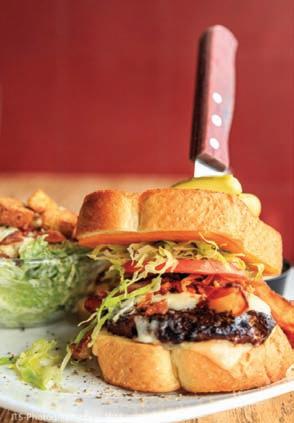
44 EAT MAGAZINE JULY | AUGUST2016
ALL YOU HAVE TO DO IS LIGHT THE BARBECUE Quality meats, Poultry, Cheeses, Specialty Products & Condiments
2577 Cadboro Bay Road, VICTORIA 592-0823
g LIQUID ASSETS


Rosé
By Larry Arnold
Rivera Castel del Monte Rose 2015 Italy $14.00-16.00
Another winner from this winery and Castel del Monte. Made with Bombino Nero, a variety perfect for the production of rose. Very refreshing and nicely balanced with subtle strawberry and cherry flavours and palate cleansing acidity.
Gassier Sables d’Azur Rose 2015 France $17.00-19.00
Good dry French rose is the perfect thirst quencher on a hot summer day and this lovely salmon hued rose from Provence, does not disappoint. Soft and fruity with delicious berry flavours, zesty acidity and a clean dry finish.
Whites
Rivera Bombino Bianco 2014 Italy $16.00-18.00
Bombino Bianco is the perfect wine for summer! The grape is indigenous to Castel del Monte on the Salento Peninsula in the south of Italy. The wine is crisp but complex, with ripe tropical fruit, almond and aniseed on the nose, tangy fruit flavours, good weight with a slightly oily texture and mouth-watering acidity. One heck of a tasty white, unexpected and totally delicious.
Esprit du Rhone Cotes du Rhone Blanc 2013 France $14.00-16.00
This delicious white blend is a veritable potpourri of white grapes varieties produced in the Rhone Valley. Fresh and fragrant with lovely floral scents, crisp nectarine, citrus and spice flavours and a long rich finish.
Spy Valley Marlborough Pinot Gris 2014 New Zealand $20.00-23.00
This unctuous Pinot Gris from the south island is a real cracker, with concentrated citrus, mineral and honey aromas. On the palate the wine just seems to intensify with good weight, an oily texture and powerful pear, citrus and mineral flavours. Nicely balanced with clean acidity and a long persistent finish.
Reds
Bodegas Sierra de Guara Evohe Garnacha 2014 Spain $18.00-20.00
Old vine Garnacha in the right hands can be a beautiful thing. When the fruit is sourced from organic vineyards, has never seen a stick of oak in its production, is full-bodied and bursting with ripe cherry and boysenberry flavours and is blessed with an underlying tannic structure that melds seamlessly with the power and complexity of the fruit—that my friend, is a beautiful thing that should not be missed!
Perseus Merlot VQA 2014 British Columbia $19.00-22.00
The fruit for the 2014 Merlot was sourced from fruit grown at Cerqueira Vineyard, located on the lower Black Sage Bench between Oliver and Osoyoos. Aged in a combination of new and used French and American oak for 16 months, Perseus Merlot is rich and full bodied with a silky texture and concentrated blackberry, cherry and spice flavours. Very impressive.
Gil Family Estates Laya 2014 Spain $15.00-17.00
Laya is a blend of Garnacha Tintorera and Monastrell grown in the torrid heat of the Almansa region of southeast Spain. Ripe and generous with a spicy, berry-scented nose, concentrated fruit flavours and a rich, supple texture. An incredible value for everyday drinking.
Glen Carlou Haven Shiraz 2014 South Africa $18.00-20.00
Medium to full-bodied with a silky texture and lush black cherry, chocolate and currant flavours, fine-grained tannins and a long supple finish. Fresh and lively with good fruit character in an easy drinking style.
Seghesio Family Vineyards Sonoma Zinfandel 2014 California $34.00-37.00
The fruit comes from selected lots of Zinfandel grown throughout Sonoma County. The final blend contains a small amount of Petite Sirah, added to enhance the colour and structure. This is a tightly knit, muscular red with concentrated raspberry, bramble and spice aromas. The palate is dense with layers of juicy black fruit, more spice and blueberry flavours that develop and expand as the wine is exposed to air. Perfectly balanced with a nicely integrated tannic structure. Superb.
Poco do Lobo Cabernet Sauvignon 1991 Portugal $21.00-23.00
I don’t think I have ever enjoyed a twenty-five year old wine that tastes this good and is still available on wine store shelves for this price. Absolutely amazing. Caves Sao Joao is a small traditional firm renown for producing red wines that can age. This cab is a fine example. Very rustic but still has plenty of life and lots going on, with blackberry, cassis and smoke on the nose. Still plenty of red fruit with nuances of tobacco leaf and aniseed on the palate. Nicely balanced with good acidity and fine tannin. A great buy for the buck.
Vecchia Cantina Chianti 2014 Italy $12.00-14.00
Founded in 1937, Vecchia Cantina de Montepulciano is the oldest wine-producing cooperative in Tuscany. Located in the heart of the Vino Nobile di Montepulciano region, the cooperative produces a range of Tuscan wines including Chianti. There’s a lot going on here, with layers of red cherry, spice and dusty earth aromas. Mediumbodied, with soft fruit flavours nicely balanced with good acidity and a rasp of finegrained tannins.
45 www.eatmagazine.ca JULY | AUGUST2016 1715GovernmentStreet 250.475.6260 www.lecole.ca eat@lecole.ca Dinner5:30-11pm TuesdaytoSaturday
The Up Island Buzz
Cowichan Valley, Gulf Islands, Nanaimo, Comox Valley & Tofino-Uclulet
COWICHAN VALLEY | UP ISLAND:
July & August 2016 are once again shaping up to be great festival months - with so many to attend, it will be hard to pick just one...
Start off in Cowichan on the Grape Escape Bike tour for MS July 23 & 24th. The tour begins Saturday morning, choose the length of route you are comfortable with and which farms, cidery, and wine estates you wish to visit. The sampling is up to you! (cowichangrapeescape.com)
On August 6th & 7th Salt Spring Island hosts their annual Music &Garlic Festival The festival takes place at Paradise Farm, a beautiful rural location on the south end of Salt Spring Island with breathtaking views of the ocean. Over two-dozen farm vendors will be on site selling organic produce, including over a dozen varieties of locally produced Salt Spring garlic. There is nothing better than crisp, white, first-of-the-season garlic to eat on its' own—if you dare!—grill on the barbie, or roast till sweet, nutty and fragrant. (saltspringmusicandgarlicfestival.com)
Galliano Island launches their 2016 Beer & Wine Festival on August 12th, offering tastings from local boutique wineries, ciders, and beers, all accompanied by delectable nibbles. What better way to spend a sunny afternoon while also supporting The Islands' Health Care Clinic. (gallianowinefestival.com)
Head to Mt Washington for Tapped Beer Fest on July 15th. This year's event includes a variety of craft breweries, a beer seminar, live music and a pig roast. Enjoy it all while soaking up beautiful mountain views from Raven Lodge. A beer seminar will be led by Jeff Lucas, the General Manager of Cascadia Liquor. He has both his Prud’homme and Cicerone level 1 certification, for those of you who like to debate brews. Maybe you prefer sampling local wines instead of brew? If so, Mt Washington hosts their Alpine Wine Festival on August 12th. Enjoy an informative wine seminar, wine samples and light appetizers followed by a gourmet bqq on the sun-drenched patio. (mountwashington.ca)
Campbell River offers the last to choose from; their much anticipated Salmon Festival on August 6th. Of course there will be a salmon bqq for either lunch or dinner, food vendors and highly entertaining logger competitions- a great way to feast on the 'King' of our Pacific seafood chain, fresh caught and prepared by local chefs. (crsalmonfestival.com)
There are a couple of new venues on the scene in Comox and Courtenay which don't have a 'best before' date on them—go whenever your heart desires—the first being a new collaboration between popular Gladstone Brewing Co. and iconic Atlas Café. The two have created an interesting vibe in the coffeehouse-by-day, turning it into a place to gather for great local beer, good food, and good friends by night. Located at the corner of Cliff and Fifth (former location of Zocalo’s), Cornerstone Cafe & Taphouse brings a welcome approach to eating out In the Valley.
If you have sampled Milano Coffee in Vancouver or even Toronto you will be thrilled to welcome Milano Boutique Coffee Roasting Co. to Comox. Located just across from St Josephs Hospital the scent of freshly ground beans and dark, rich espresso made in the Italian fashion, swirls through the air as you enter the modern state of the art roasterie. Master roaster Brian Turko brings years of experience to his espresso bar group with the west coast heart and Italian soul; it's a coffee experience like no other so head in and try one or more of the 8 different espressos available all the time. (milanocoffee.ca)
Mary's won't be new to quite a few Comox residences who already enjoy her amazing gluten free, refined sugar free or dairy free baked goods, but now it will be much easier
for everyone else to enjoy her treats, coffee and lunches since she recently opened her dedicated location on the corner of Church & Comox Ave. The hard part will be sharing all of your faves with the new admirers in town! Check her fb page to stay abreast of what's available on a daily basis.
You now have a full two months of culinary attractions ahead to tempt yourself with; select carefully and once you're done find your way to the Valley to complete the tour at a slower but no less rewarding pace. —
KIRSTEN TYLER
TOFINO | UCLUELET:
Summer is really all about food trucks and now there’s a new one to enjoy in Tofino.
Salish Spoon is located on Jamie’s Whaling Station’s property at 606 Campbell St. in the lower parking lot next to the dock. This truck is a venture of Jamie’s Rainforest Inn’s head chef Ryan Gark. The menu has been designed for quick but delicious fare, catering especially to those on their way to or coming from an ocean adventure. Bannock features prominently, including fried bannock, bannock buns for the halibut, salmon and bison burgers as well as the bannock hot dog. A Dungeness crab bisque, the tuna tornado wrap (my current favourite), poutine, and halibut fish and chips round out the menu. The fresh lemonade is not to be missed. Chef Gark will do well with both Jamie’s adventurers and the locals.
In honour of Ucluelet’s favourite event – Ukee Days on July 22-24 – it seems like a good time to find out what new things are happening at the southern end of the peninsula.
Black Rock Oceanfront Resort recently welcomed a new head chef, David Schiafinno. David is from Peru by way of other Canadian properties, and will bring that influence to Fetch and Float, the restaurant and lounge at Black Rock. The promise of a Peruvian style ceviche more than enough to get me onto the Fetch patio, which is a draw in itself in warmer weather. We look forward to Chef Schiafinno’s take on west coast cuisine. (blackrockresort.com)
Thay Tea is located at #1-250 Main St. in Ucluelet (next to the CIBC, just up from the Ucluelet Aquarium). With over 60 organic teas available to purchase, you can also enjoy fun beverages (the tea lattes are delicious) and baked goods at the downtown tea room location. Loose leaf teas are available for purchase as well as online (thaytea.com). A new must stop in Ukee!
The Tattooed Beaver at 1627 C Peninsula Rd. is located in a cluster of good eateries that includes the Blue Room Bistro, the Barkley Café and the Cedar Room. Based on the name alone, it’s clear this one is a little different! Offering southern comfort food, the Tattooed Beaver has a simple menu based on mains with the choice of two sides. Simon the cook and owner is affable and friendly, and clearly loves his job serving up Moo Bones (delicious ribs), Jumbalaya, fried chicken, Cajun cod, and the Poor Boy prawn sub. Sides, also available on their own, include deep fried dill pickles, beer battered onion rings, baked beans and “power” slaw. Other specials include Beaver Bites (deep fried mac ‘n cheese balls), frog legs, and crocodile bites (you’ll have to go to find out). Look out for daily specials as well. For more information, visit the Tattooed Beaver on Facebook. Ukee Days itself (July 22-24) is a community festival to beat all festivals. Logger sports, live music, the wife carrying contest – it really has it all! There is also a variety of kids activities, vendors and food options at the weekend event, which takes place at the fairgrounds at 160 Seaplane Base Rd. (ukeedays.wordpress.com). —JEN DART
46 EAT MAGAZINE JULY | AUGUST2016
Salt Spring ...summer
























Once you’ve been “on island” you’ll never want to be “off island” again. From pristine beaches to breathtaking views, goat picnics to people picnics, farmer’s markets to farmer’s fields, spectacular views on the trails from Mount Maxwell to Ruckle Park, come prepared to sample everything. The food, the wine, the people, the views, the restaurants and the unique shopping. You may just want to call this beautiful island your next home.

SPECIAL EAT PROMOTION Houseboat Coastal Home and Cottage 134 Hereford Ave.
Unit 15 – 315 Upper Ganges Rd. d s R ange r G ppe 5 U 31
Photo by Wendy A Rosier, Salt Spring Island
OF THE YEAR BY VANCOUVER MAGAZINE FOR THE

SECOND YEAR IN A ROW!
I want to personally thank everyone at Stage for all of their amazing work and ongoing commitment to our number one goal: giving Victoria a great experience each and every night. It truly is my honour to work with such inspiring people and an even greater blessing to have you as family. – Graham Meckling
MY SINCERE THANKS TO:
Steven Quigley
Garth Abili
Benjamin Berwick
Dave Brooks
Tiffany Ma
Elyse-Marie Bowers
Tara Campbell
Sayo Kajiwara
Shane Andersson
Daiji Tanaka
Ian Cousins
Jack Kyne
Caity Gossland
Nathan Loos
Greg Caspersen
Nathan Case
Dion Ouellet
Julien Normand
Lance Staples
Community of Fernwood
My amazing wife Michelle and our new son Weston
STAGE WINE BAR HAS BEEN NAMED
RESTAURANT
To make a reservation call or visit: stagewinebar.com 250.388.4222


















 Lindsay Van Gyn VANCOUVER SALES Clevers Media
Lindsay Van Gyn VANCOUVER SALES Clevers Media





















 by Rebecca Baugniet
by Rebecca Baugniet




















































































 JOSEPH BLAKE
JOSEPH BLAKE
































































































































































































 by Christine Comrie, Cenote Restaurant and Lounge
by Christine Comrie, Cenote Restaurant and Lounge








































































